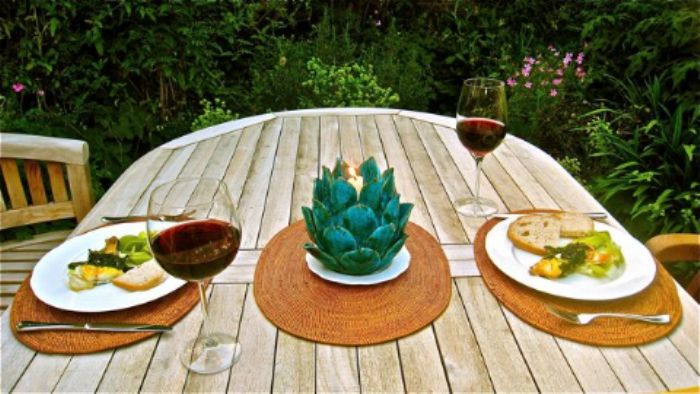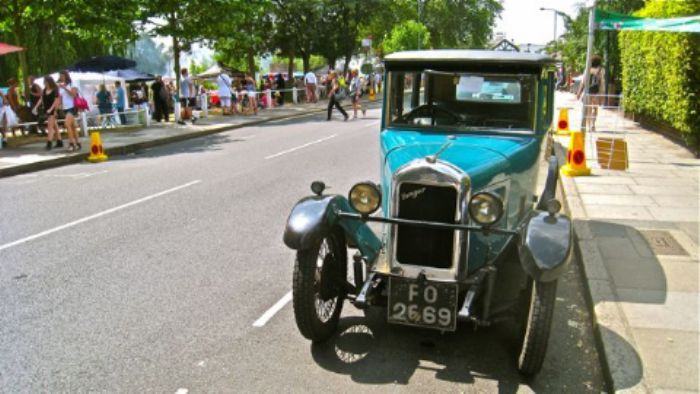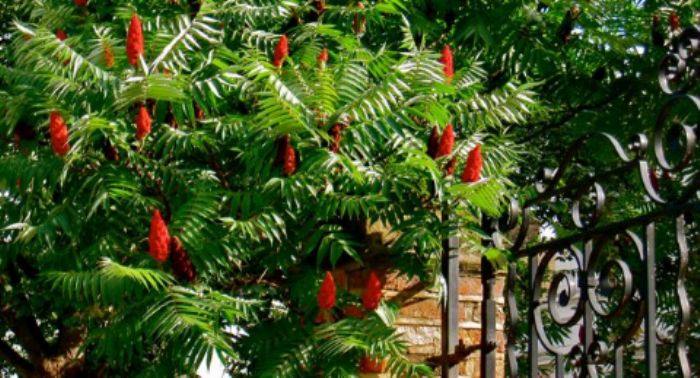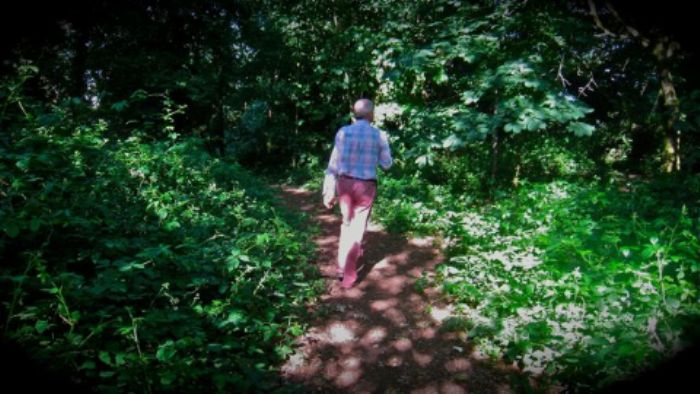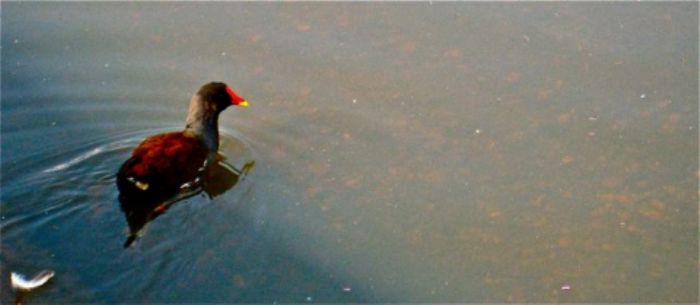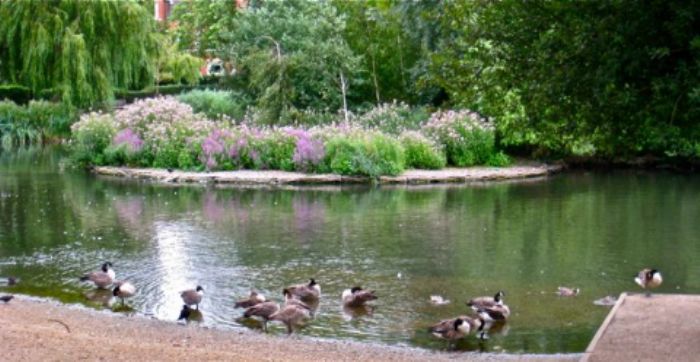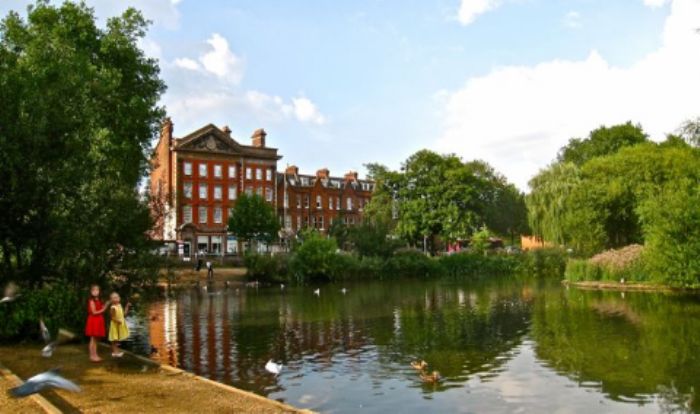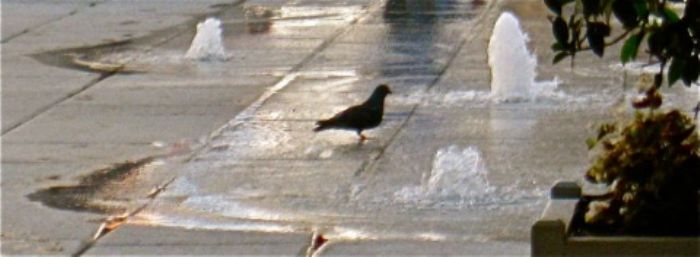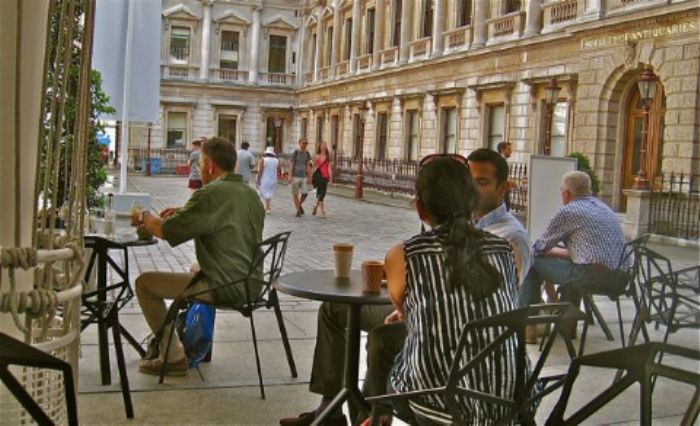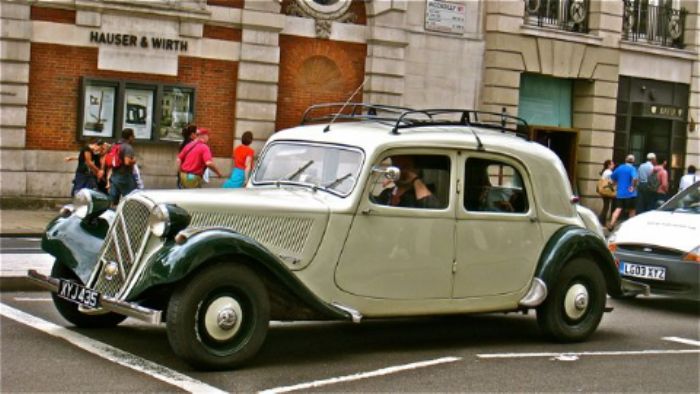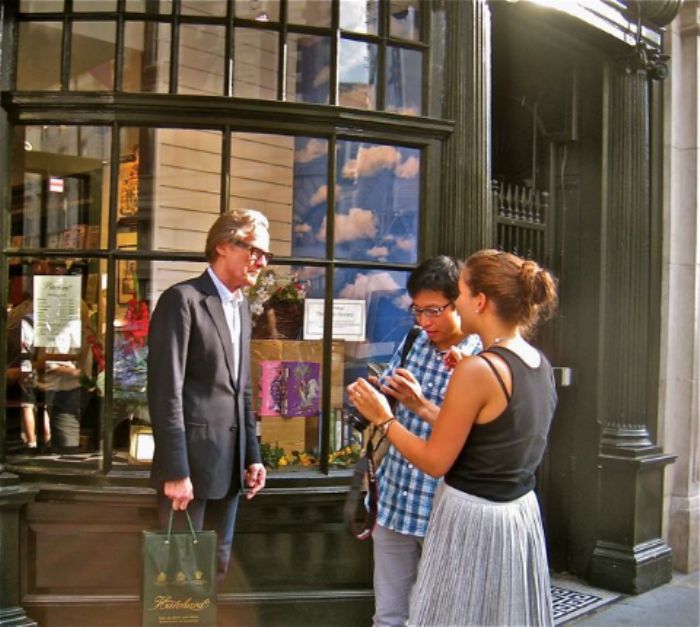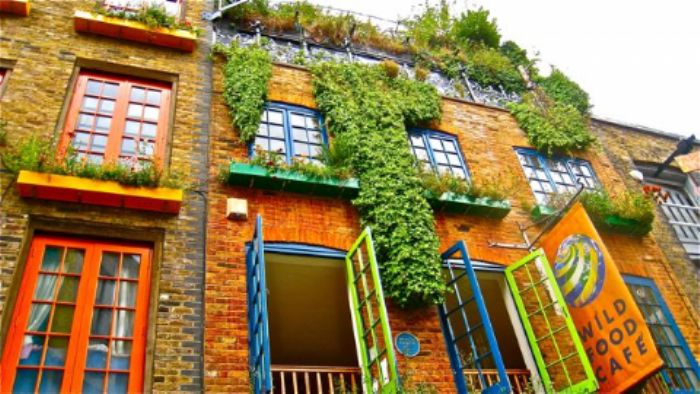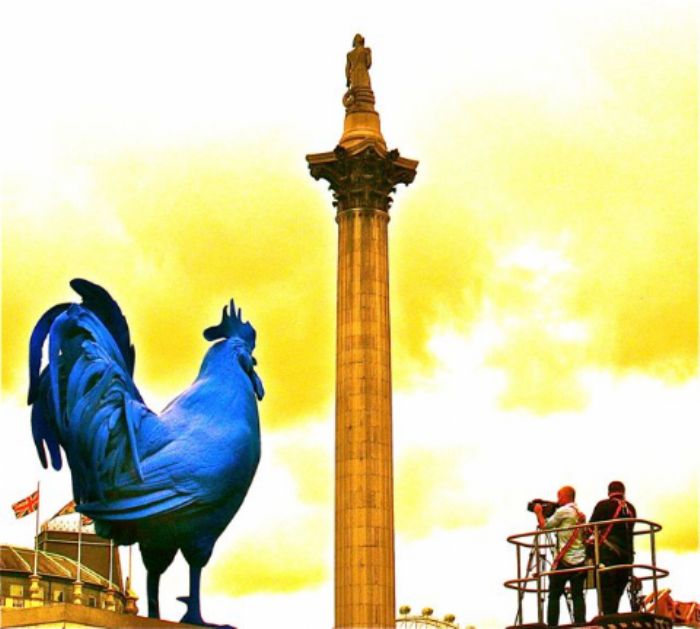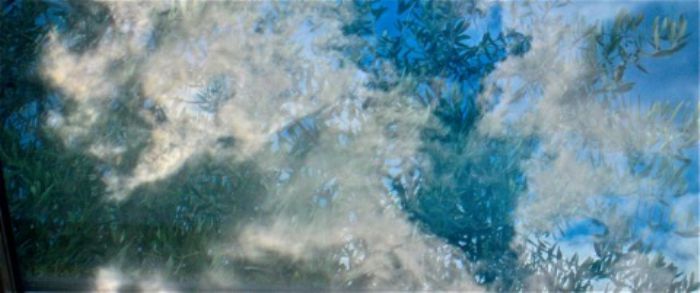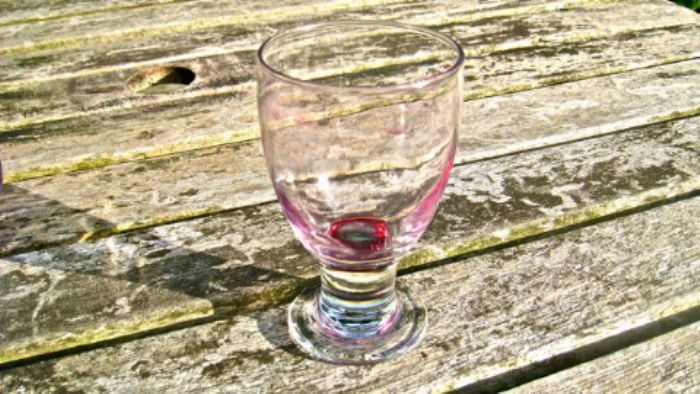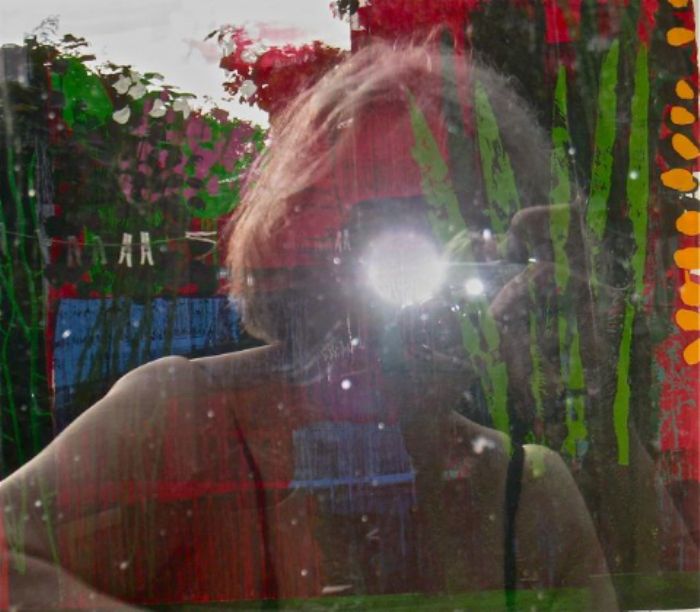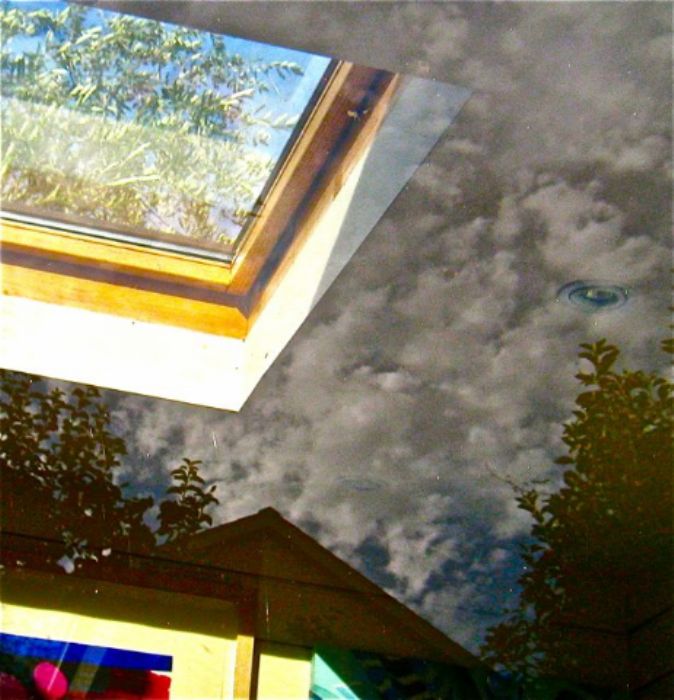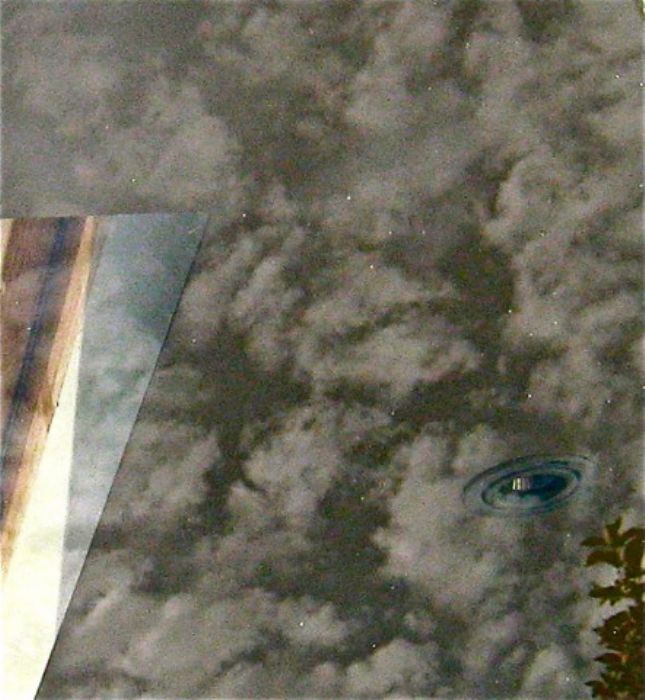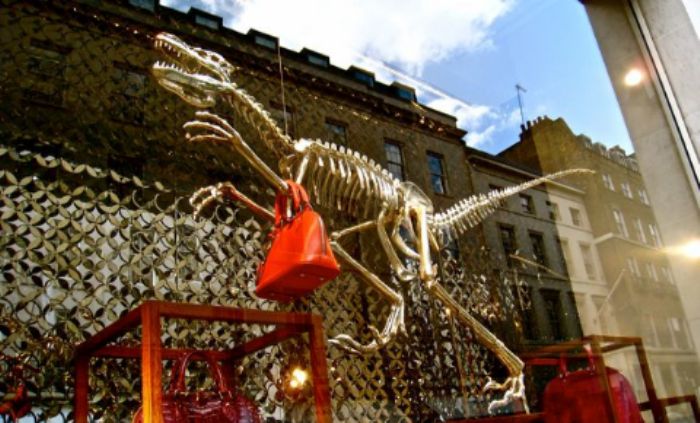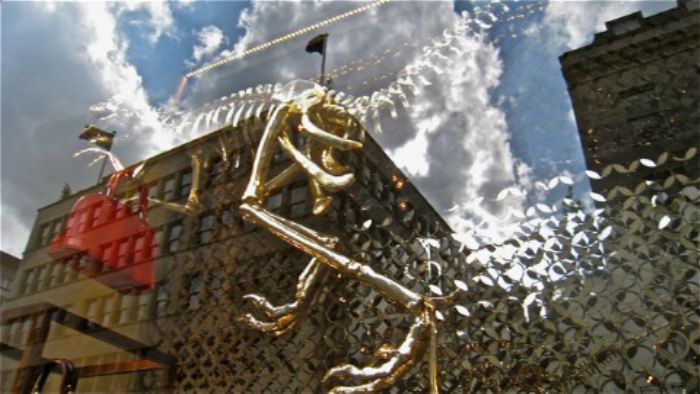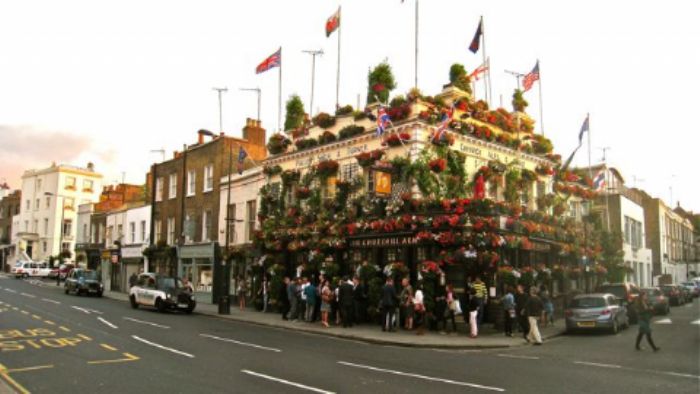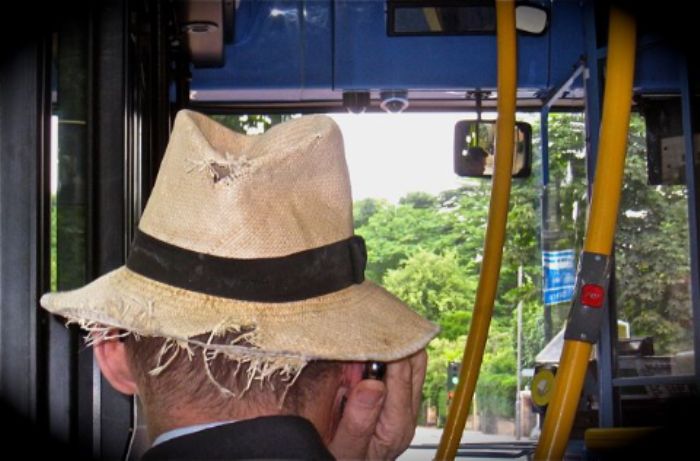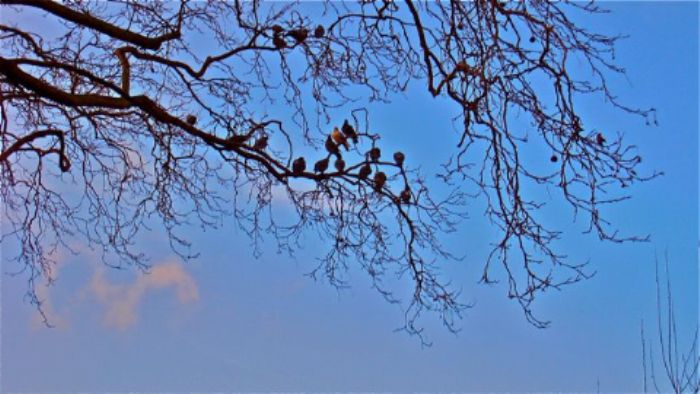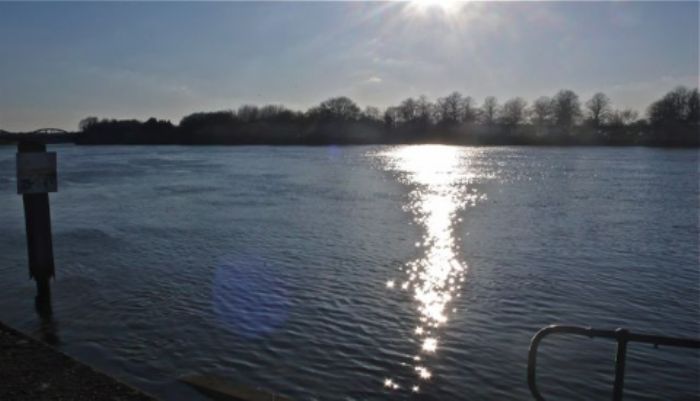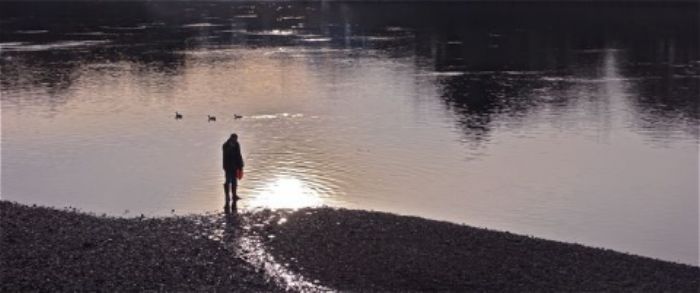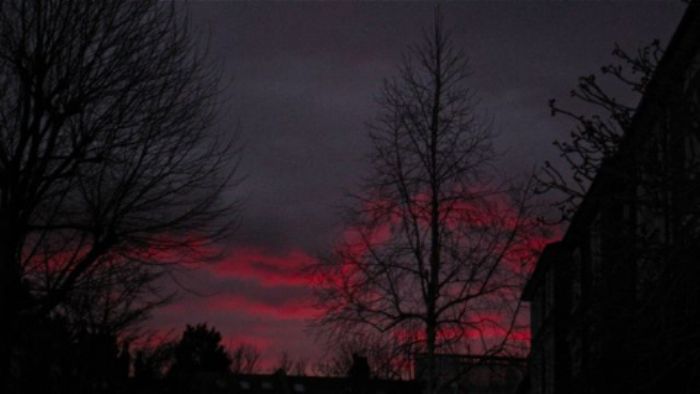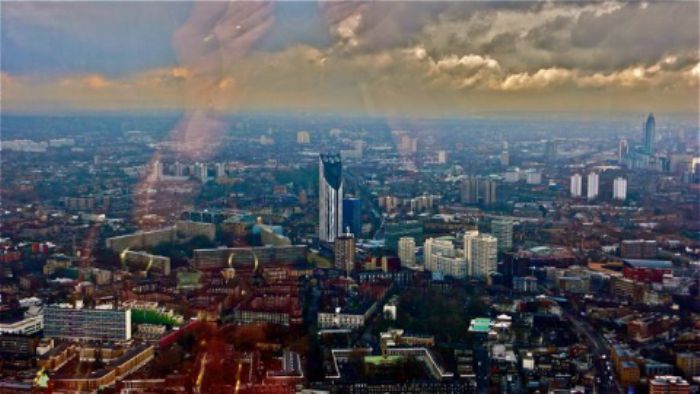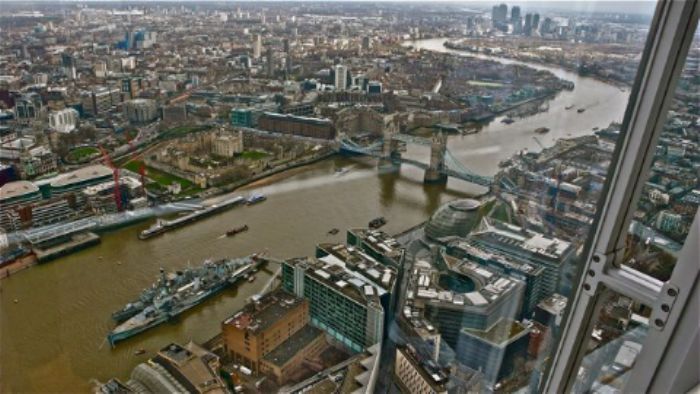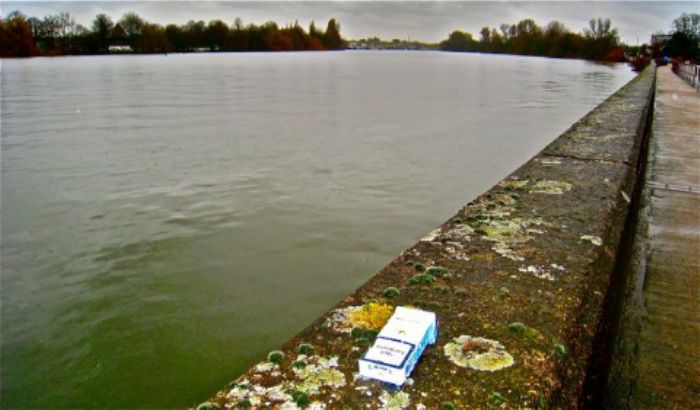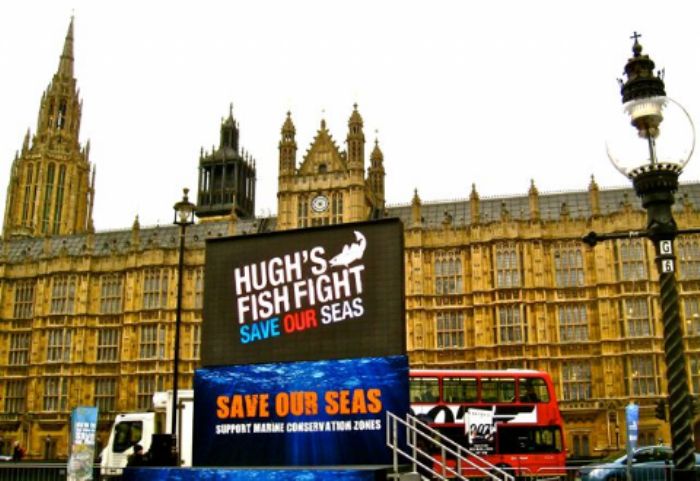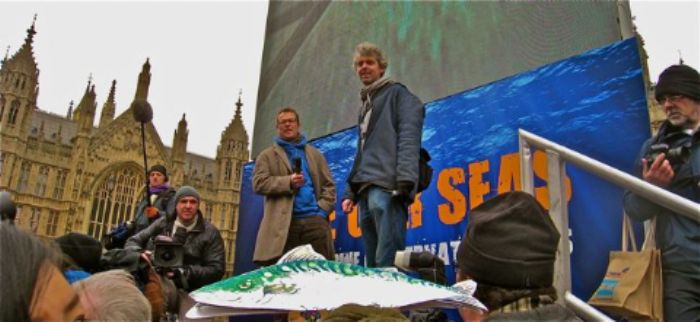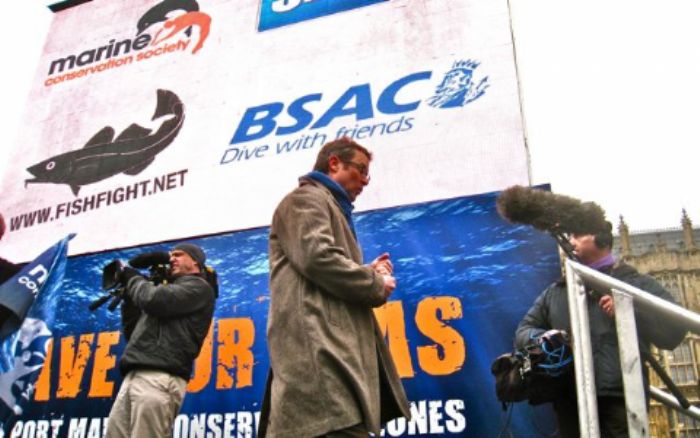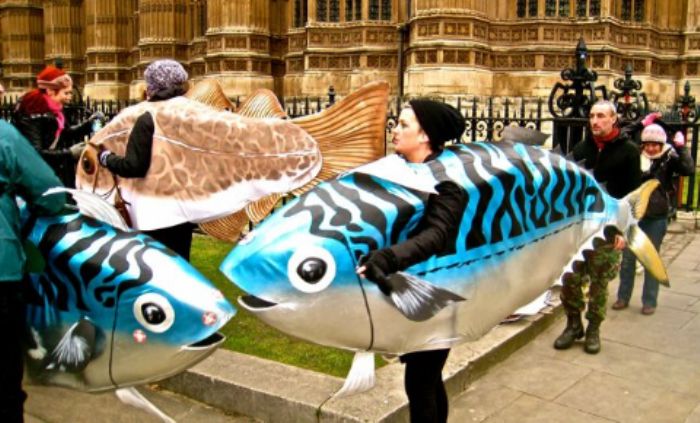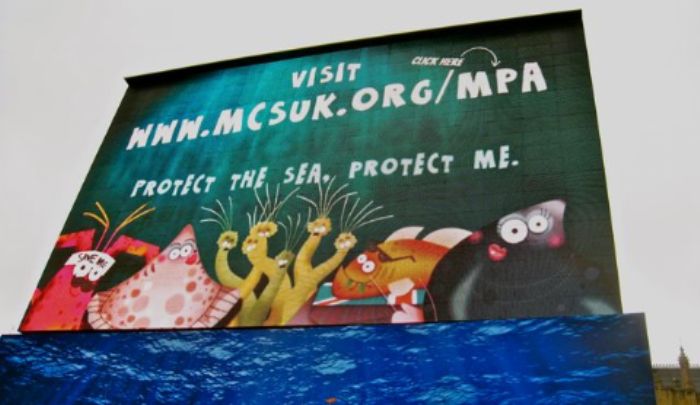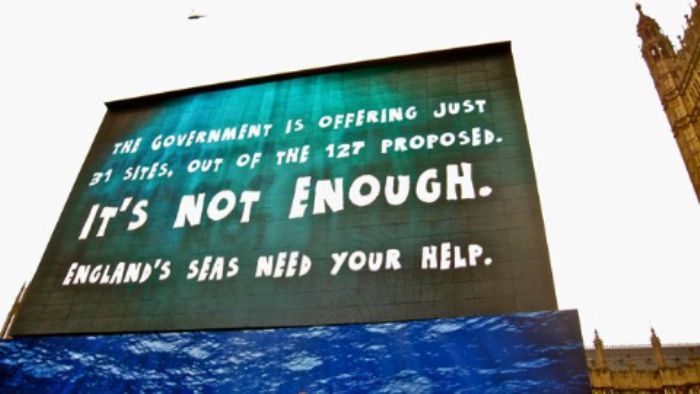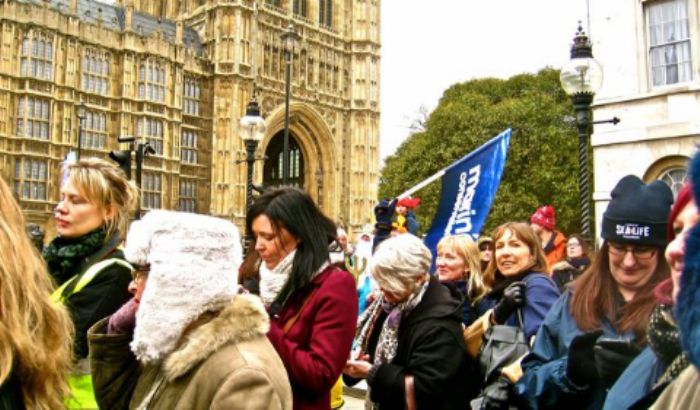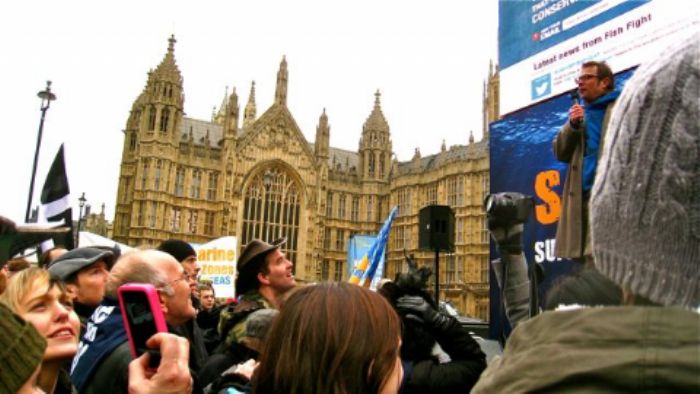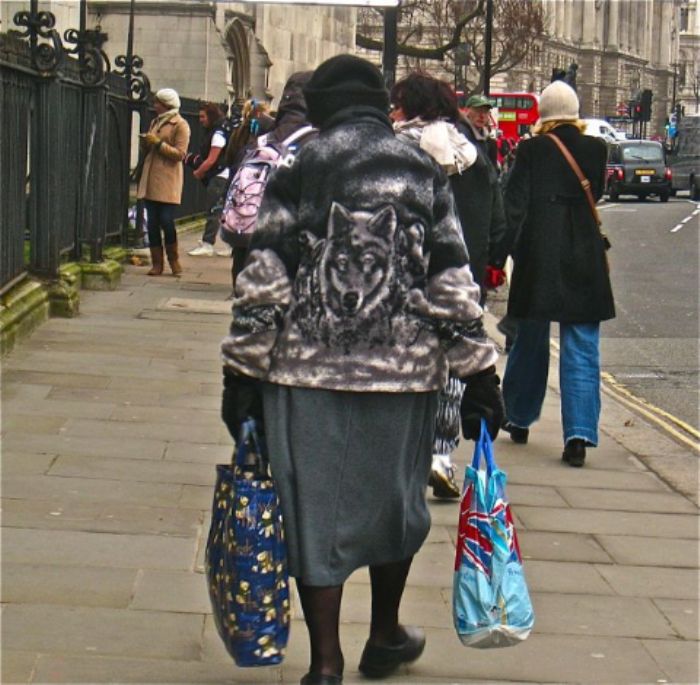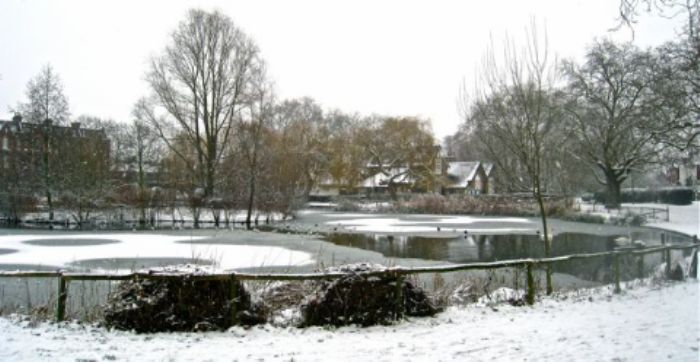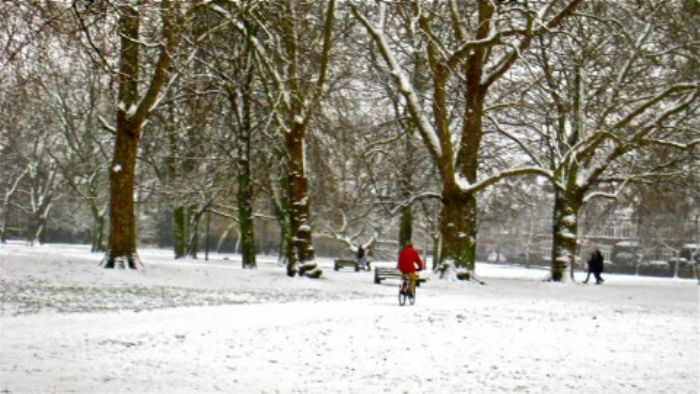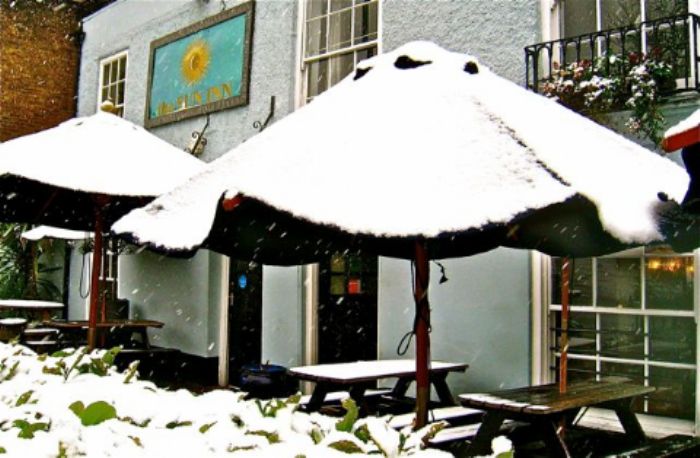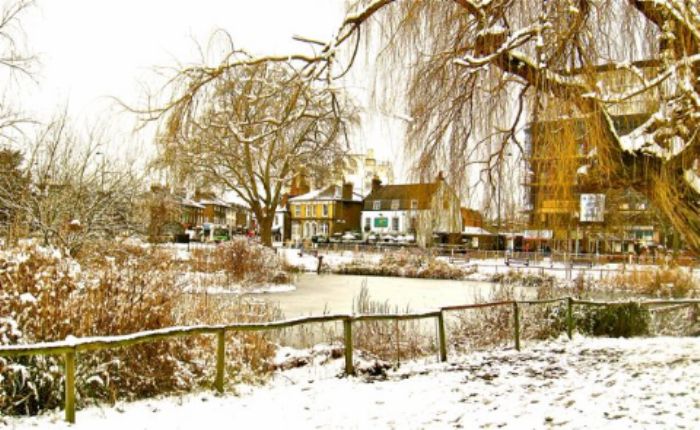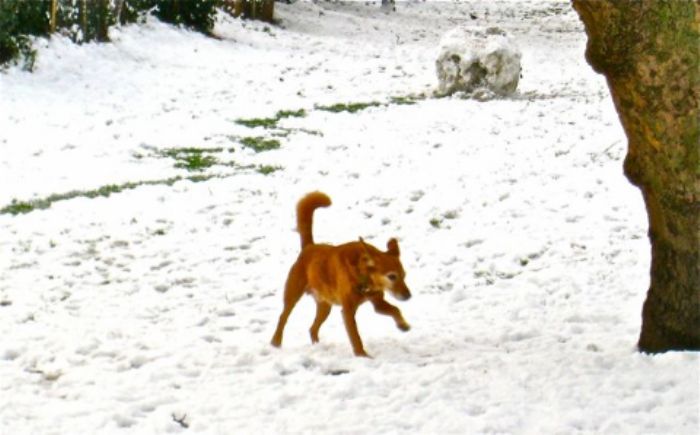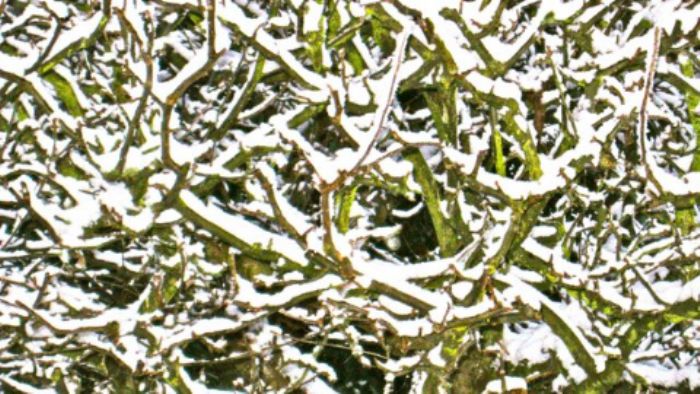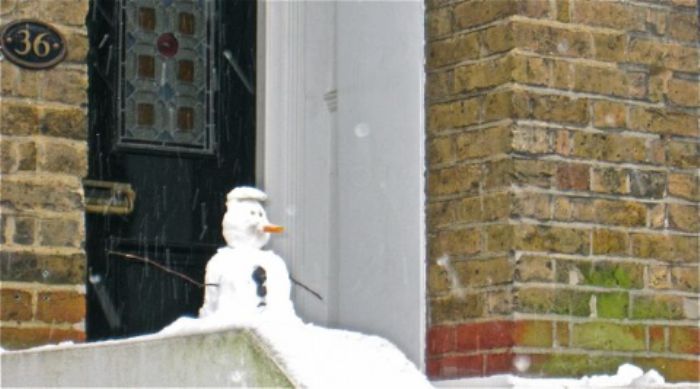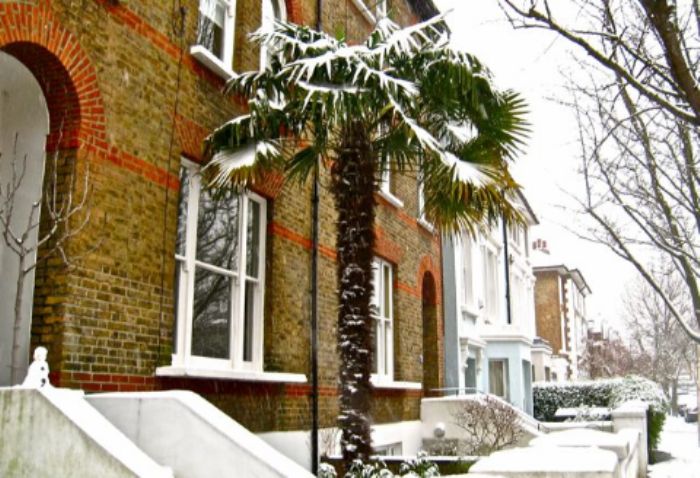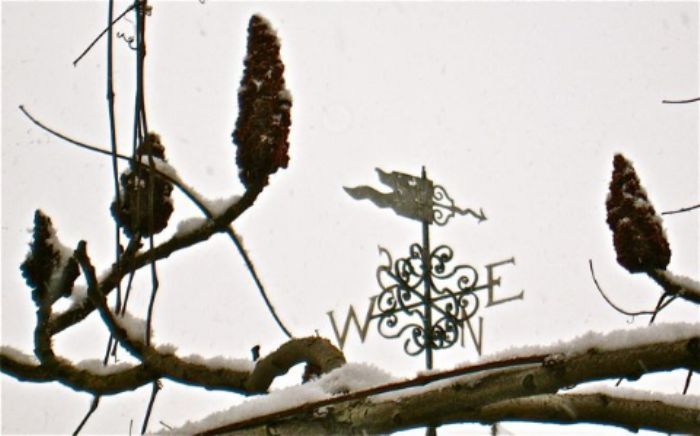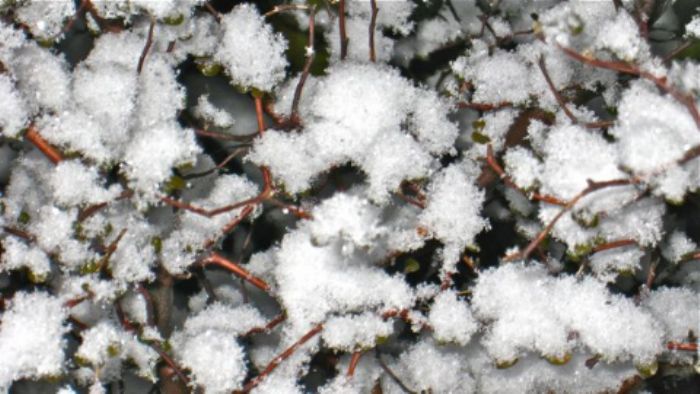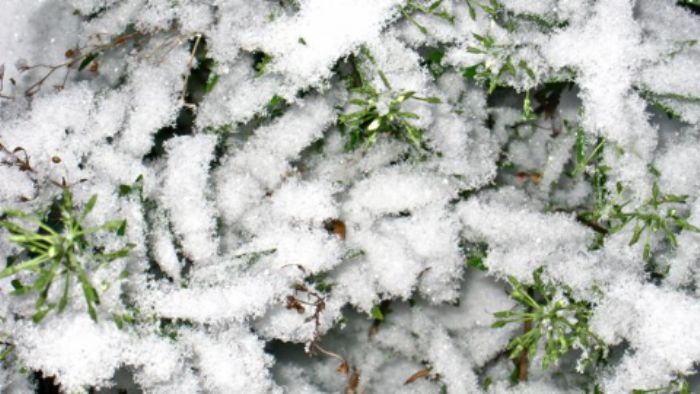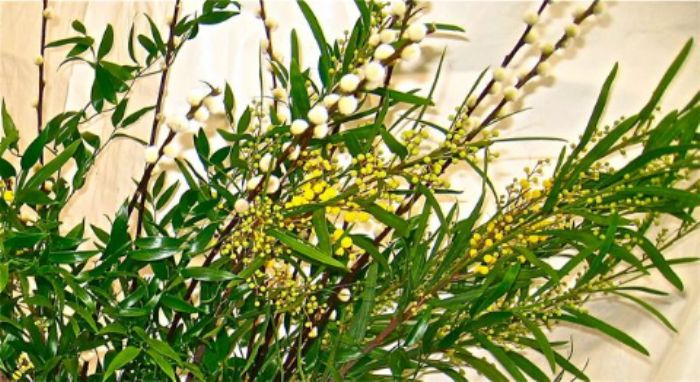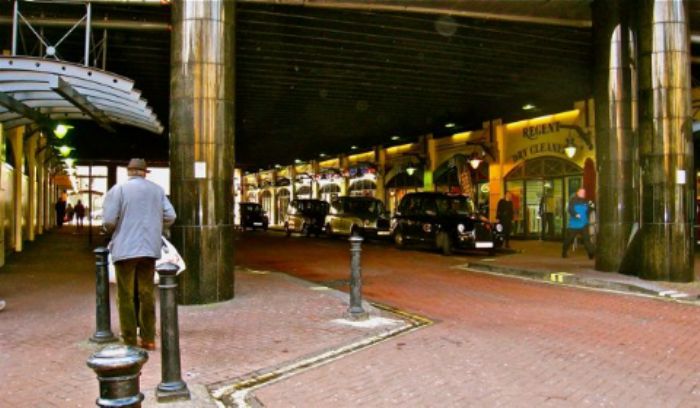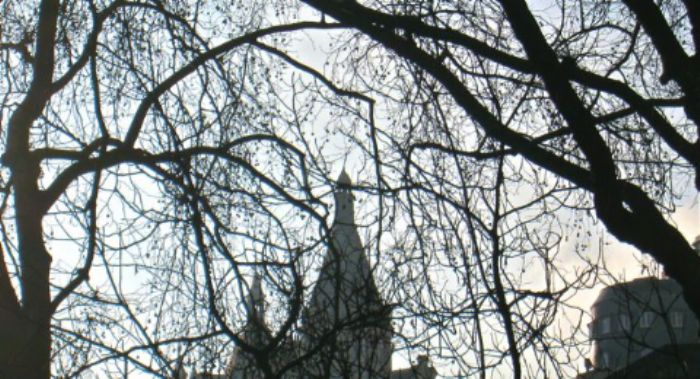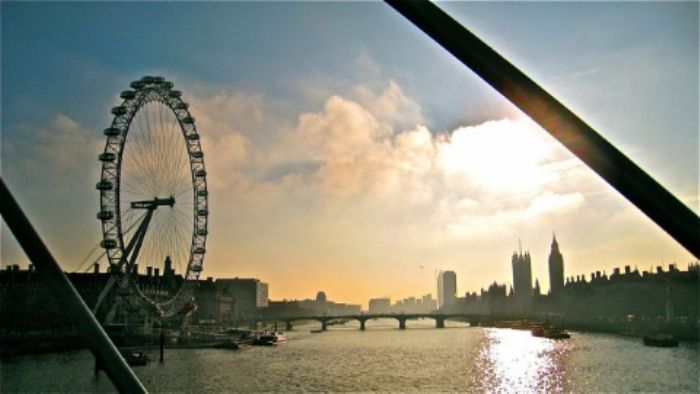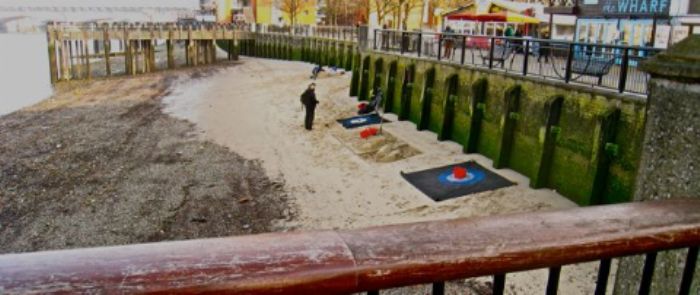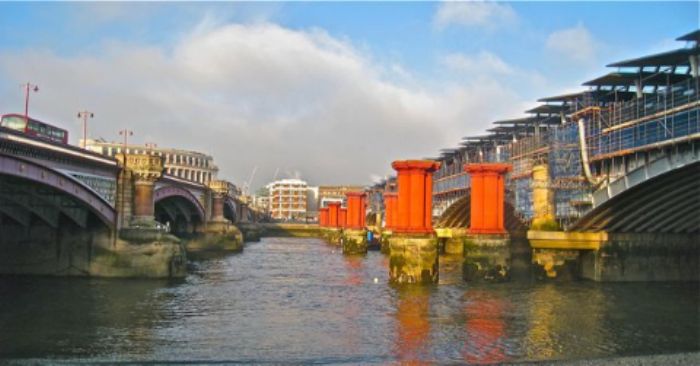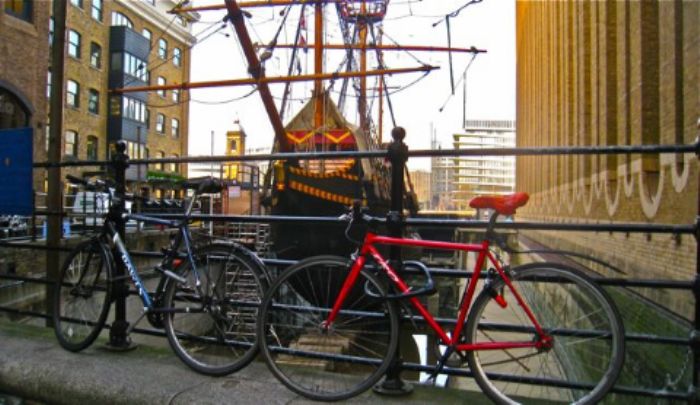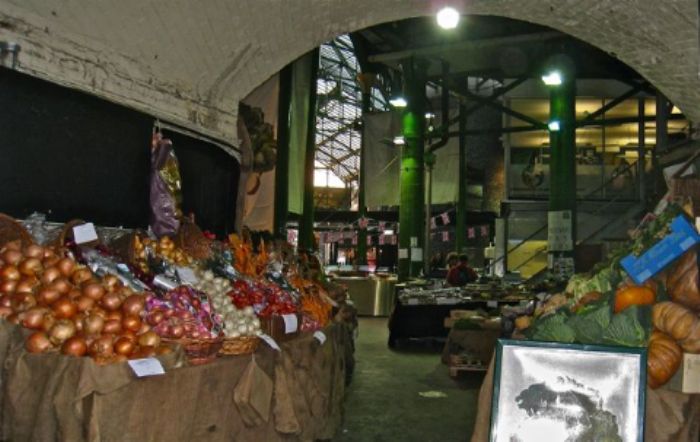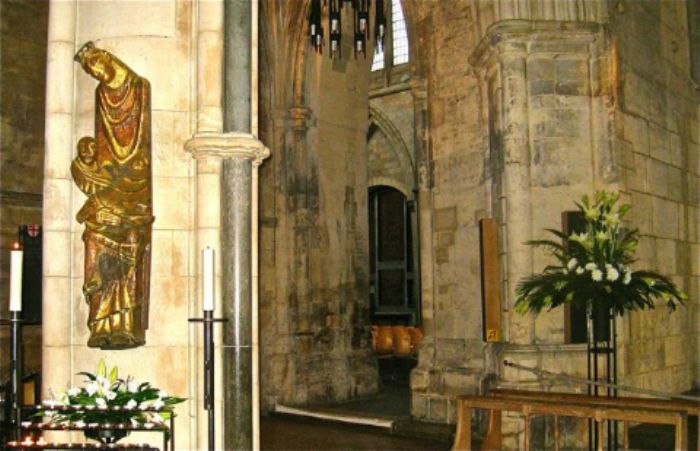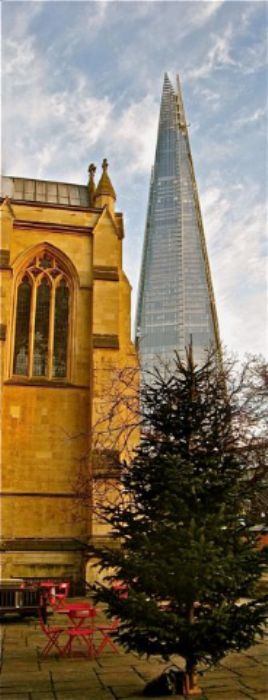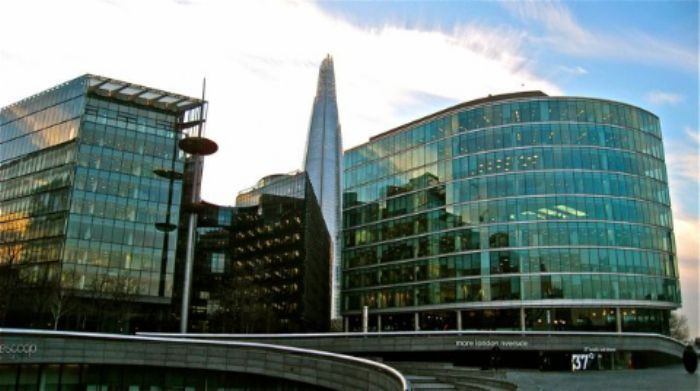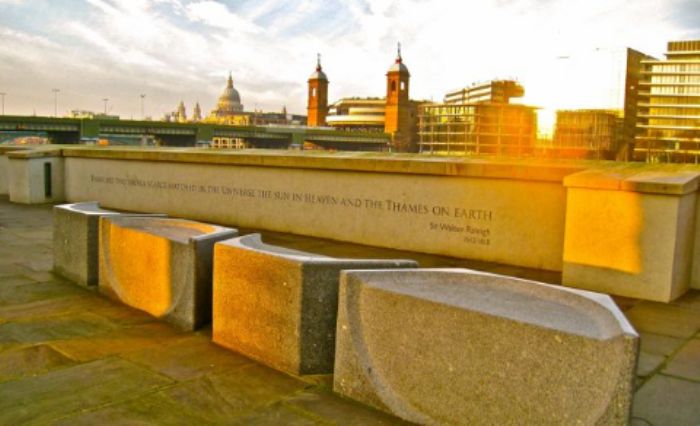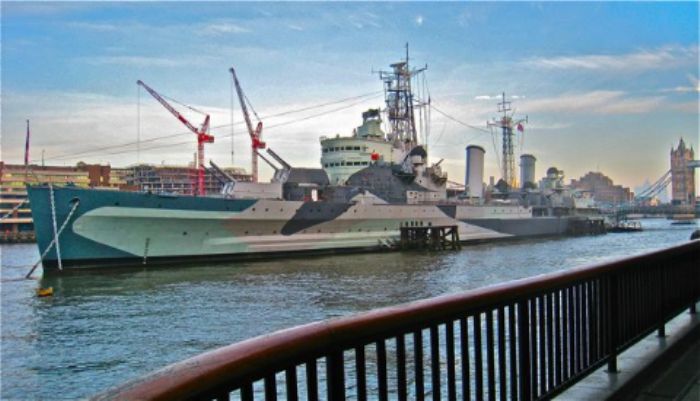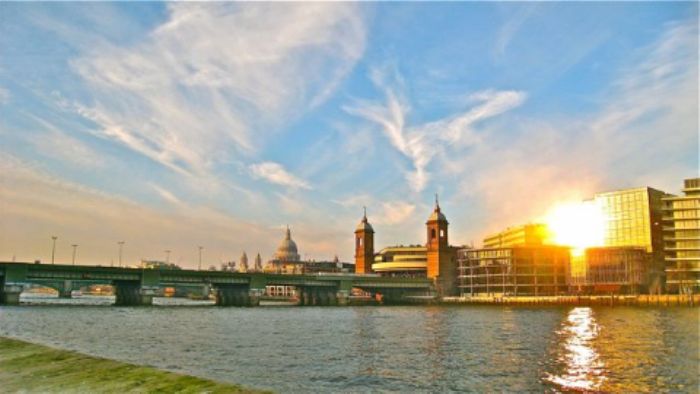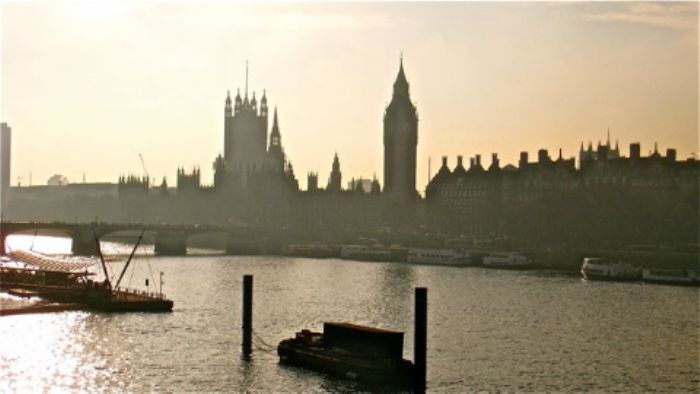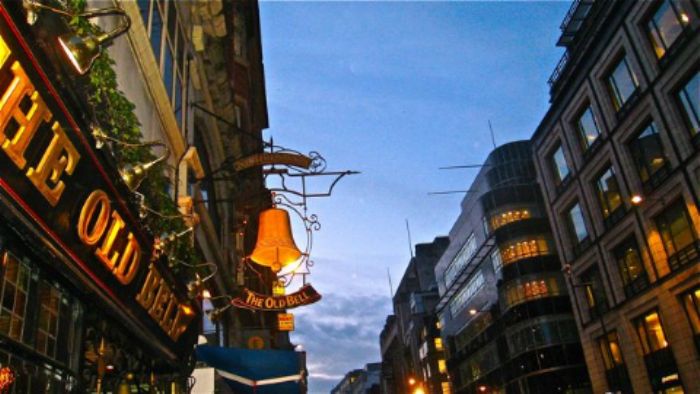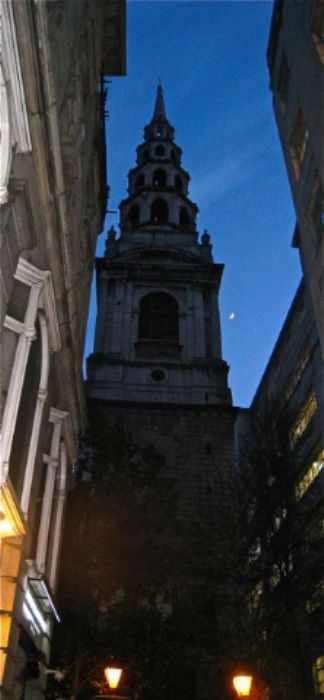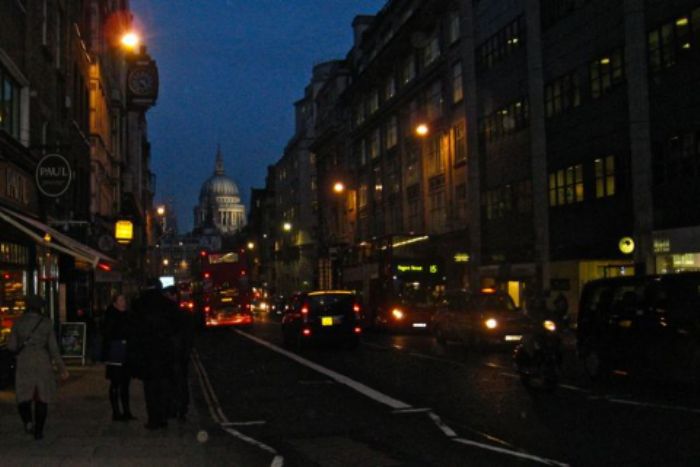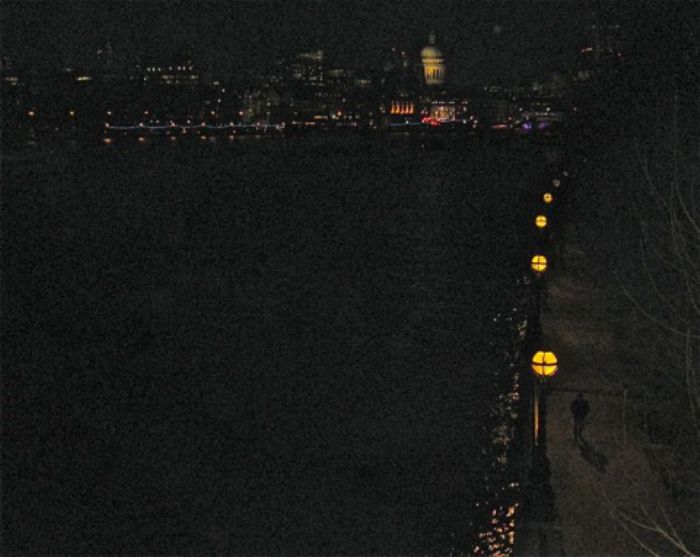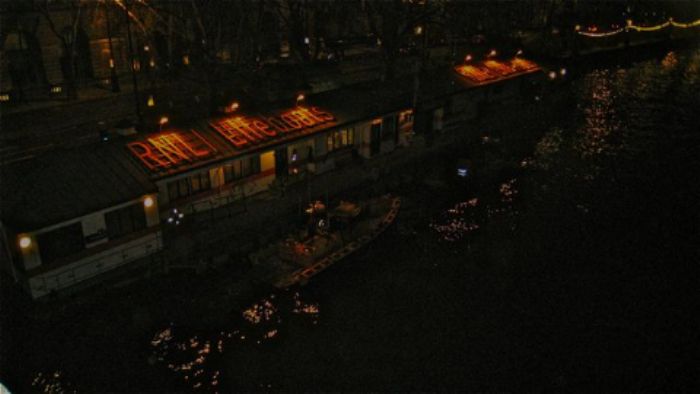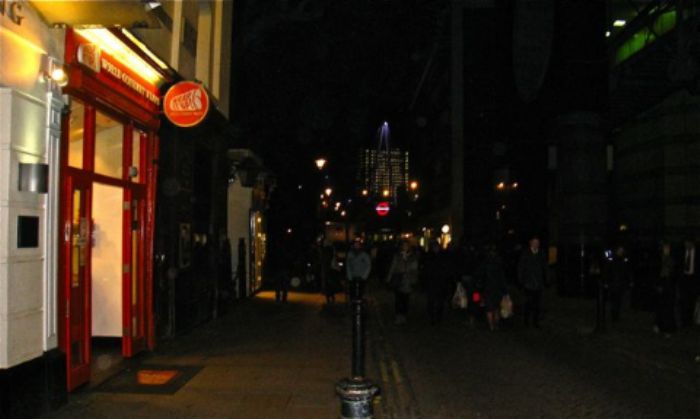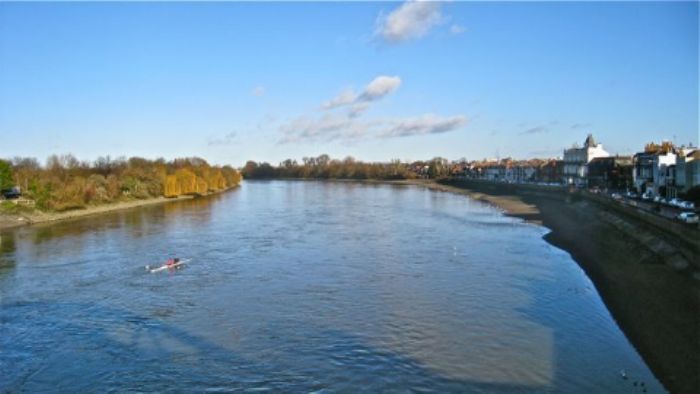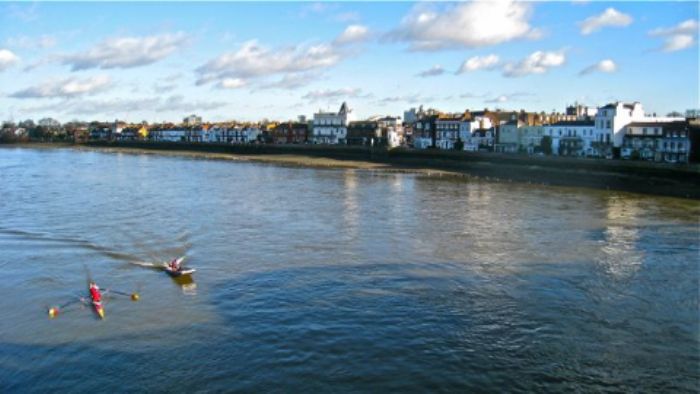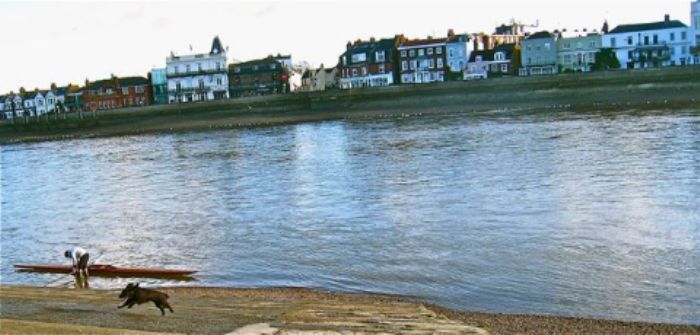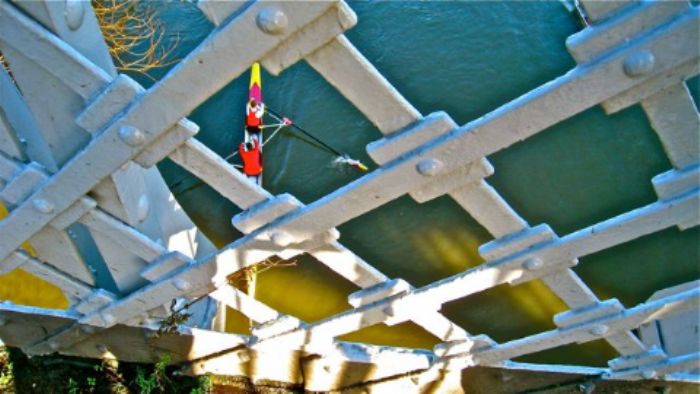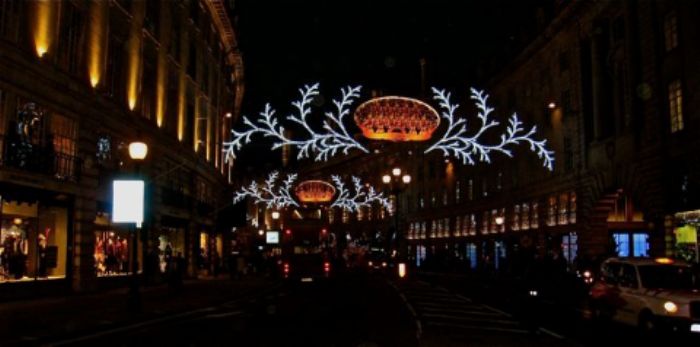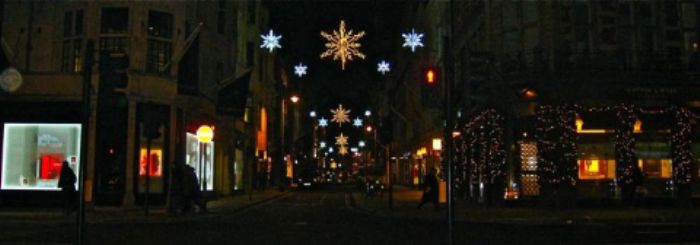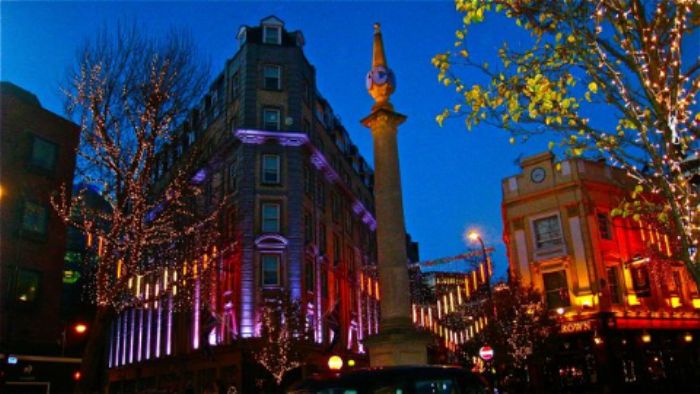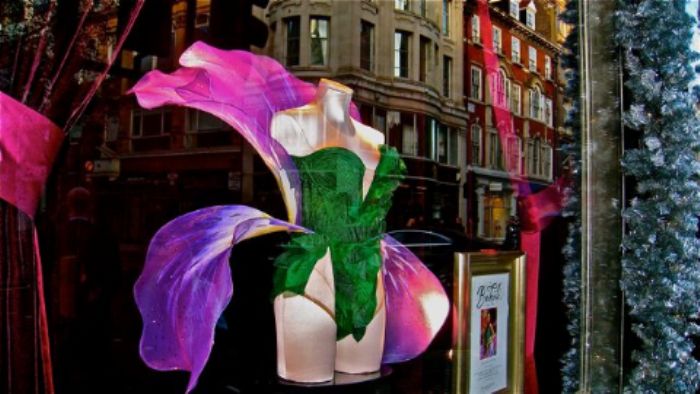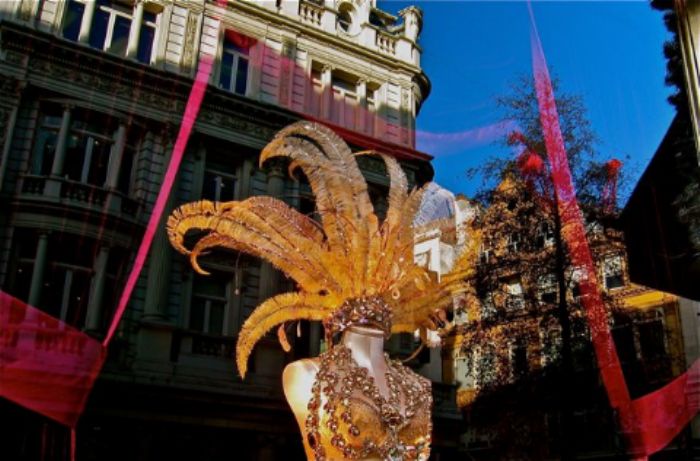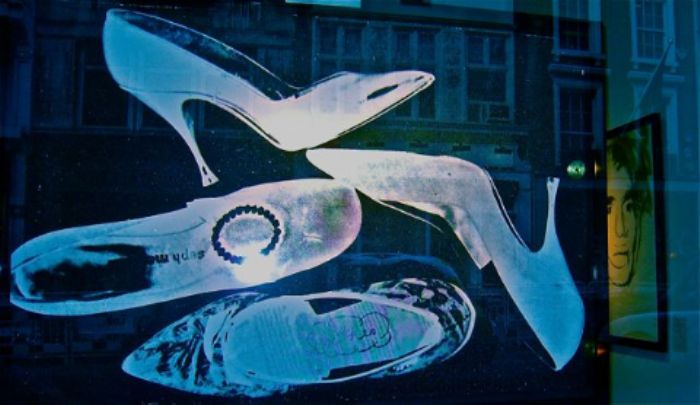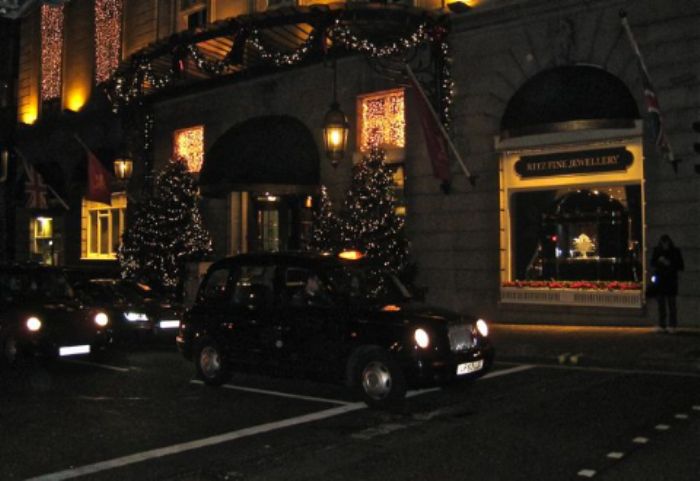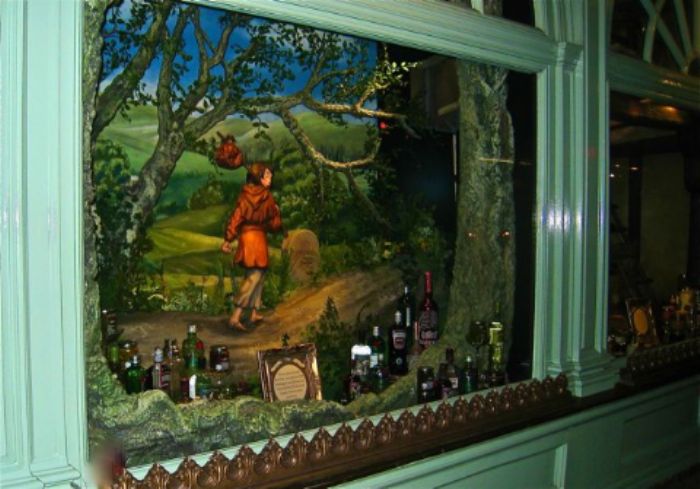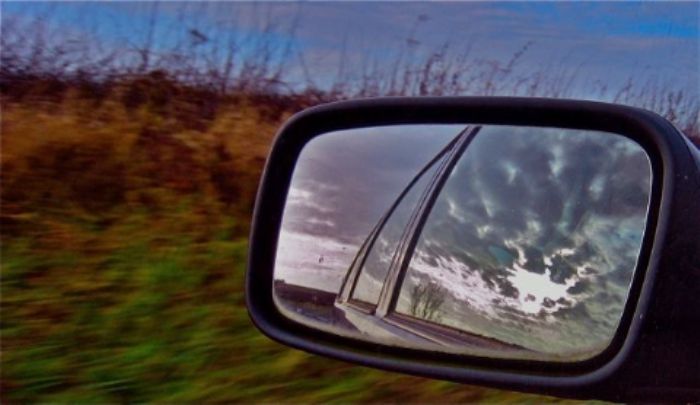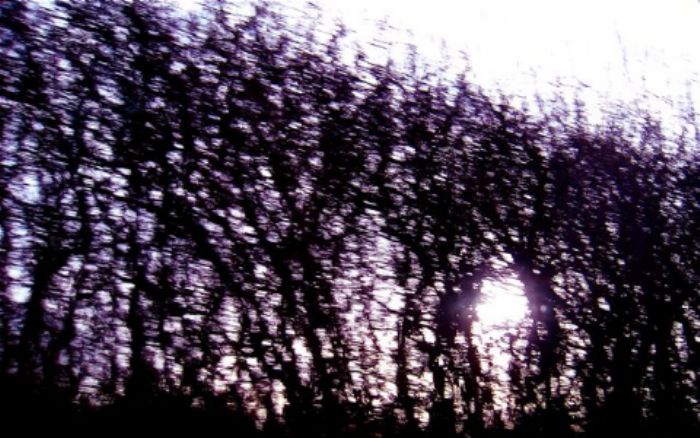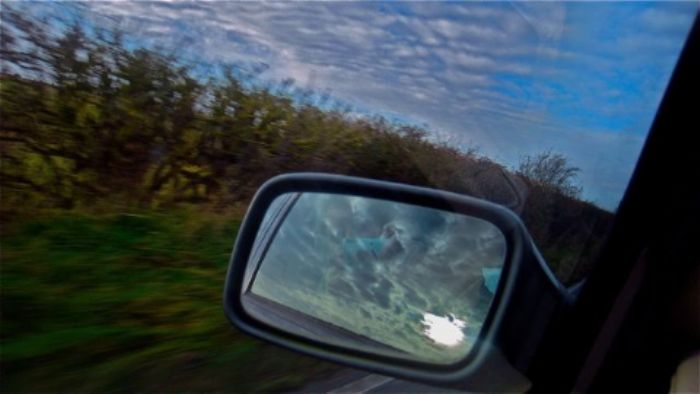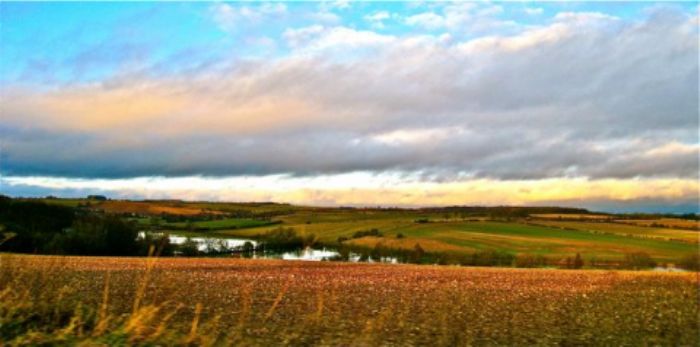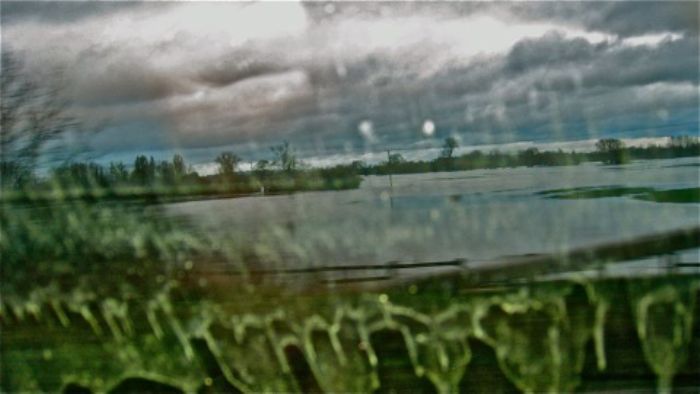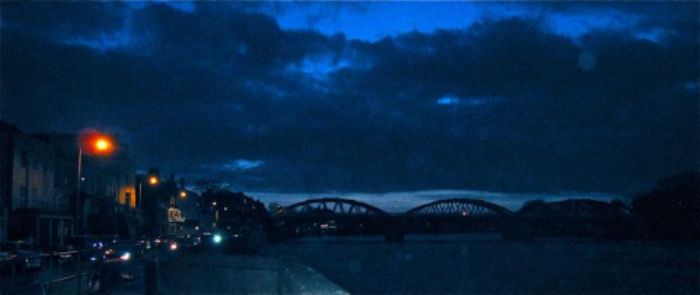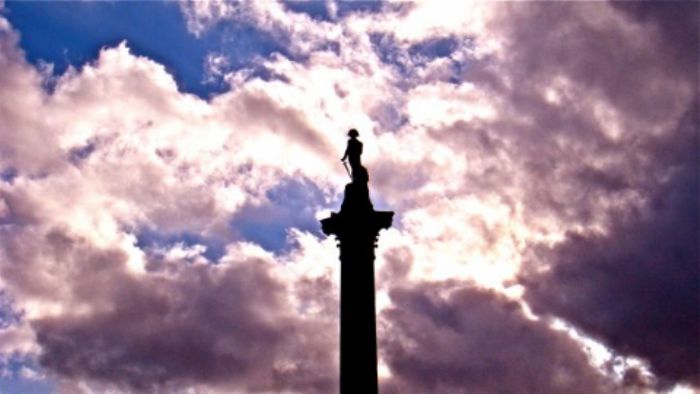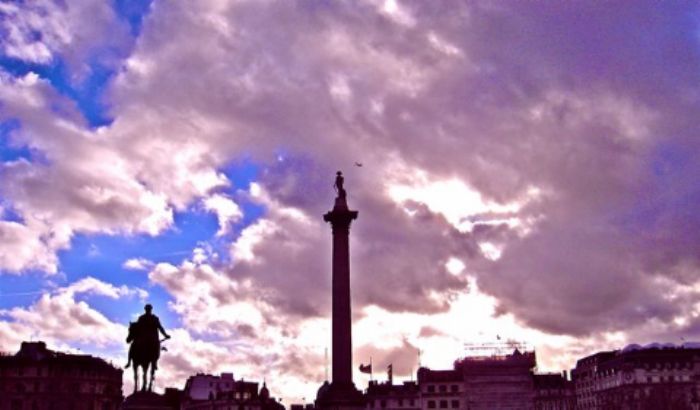We set off in driving rain. Just out of London on the M4 there’s a spooky petrol station, where I always feel caught up in a time warp. It’s blocked off by trees on all sides, eerily silent and never busy. The sort of place where time stands still – in a creepy sort of way – where you might suddenly find yourself lost in a different dimension with no voice and no way of getting back. But the petrol costs the same as everywhere else …
Heavy lorry spray and boy racers to contend with en route but the deep velvet tones of Jeff Lynne soothed my stress levels. We finally turned off on to the M5 and made a welcome stop at Buckfast Abbey, on the edge of Dartmoor. One of the monks, Brother Adam, kept bees and made honey here for over seventy years. Now he has gone and we were told that the abbey didn’t have beehives any more. A sad state of affairs, even more so given the alarming loss of bees worldwide at the moment.
After a hot and refreshing cup of coffee, we bought some honey from Exmoor bees. There is a specially good ‘monastery’ shop which sells products made by monks from abbeys all over Europe. Worth investigating – it’s in addition to the other gift shop at the entrance.
A decapitated stone head lay casually asleep on the grass as we went into the abbey grounds. Rather reminiscent of Easter Island – but a squashed version … I wonder where he came from because he doesn’t resemble an abbot – more like the man in Berwick Street market who used to sell me delicious pineapples.
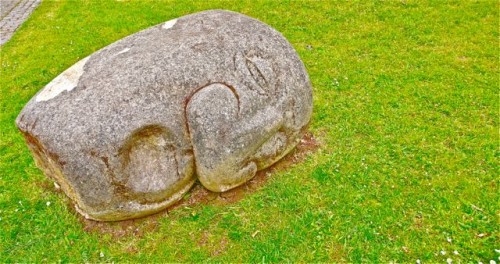
The Sleeper
There is a beautiful horse chestnut nearby, now in all its candelabra glory. It made me think how much we take trees in the landscape for granted. I hope it doesn’t have the disease that many of the horse chestnuts in London have succumbed to. Both bees and trees are suffering and we need to take note and make changes now in our selfish lifestyles if we ourselves, as a species, are to survive. We are so interdependent on the physical world – why are we so destructive of it?
As we left the M5, the roads became more and more narrow – we were squeezing between high hedges bursting with colourful wild flowers on either side. This reminded me of childhood holidays and the rising excitement of arriving somewhere new by the sea. We weren’t disappointed. The Henley Hotel is on a cliff top and we were welcomed with tea and cake in the garden. Breezy, grey clouds turning to white, sea air and snatches of blue sky. Energised again after the long drive, we walked down the steep hill to the sea and Burgh Island.
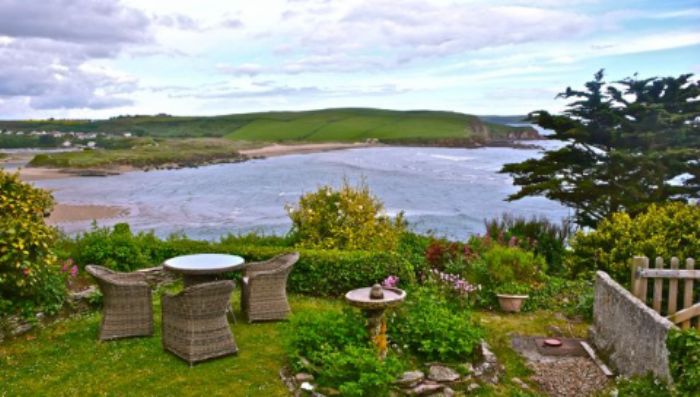
Henley hotel – cliff top garden
The tide was out, which meant we could walk across the sand to the island (of Agatha Christie fame). She based her mystery ‘Evil Under the Sun’ here. There’s a large art deco hotel, fenced off in its own grounds, covering almost half the island. It was here that Hercule Poirot solved a murder whilst on holiday. I recognised it immediately from the TV production. Agatha Christie actually lived a little way up the coast in a big white house called ‘Greenways’, overlooking the estuary near Salcombe, where the river Dart meets the sea.
At high tide, a sea tractor conveys the guests to and from the mainland. It was to be the best week of the summer so far, although we didn’t know that then. Evening sun silhouetting the surfers, fresh fish for dinner, a lighthouse winking on the horizon as the sea disappeared into the twilight. And ‘The Humans’ by Matt Haig waiting patiently in my case to be read. I wasn’t aware then of this added treat that lay in store …
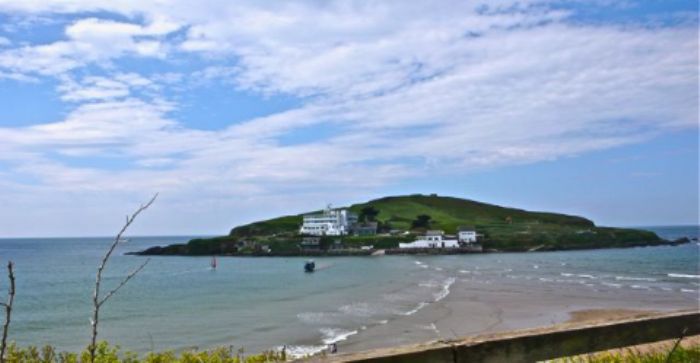
Incoming tide at Burgh Island – with sea tractor and windsurfer …
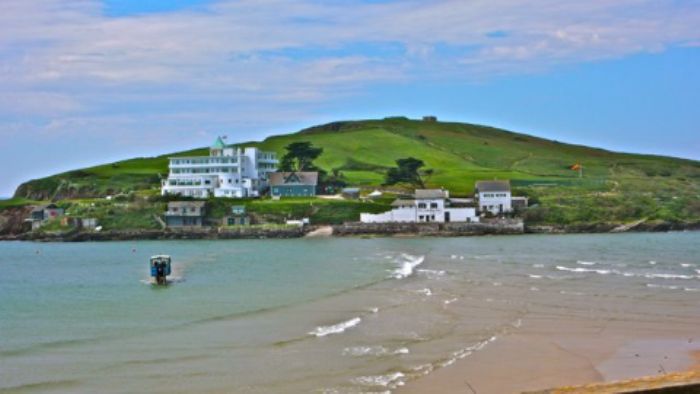
Closer …
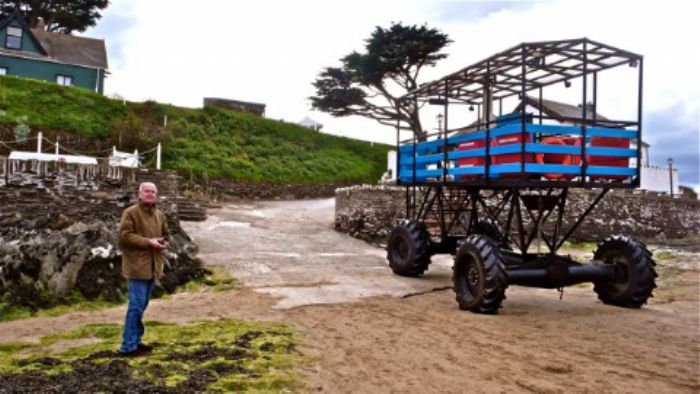
John meets the sea tractor at low tide …
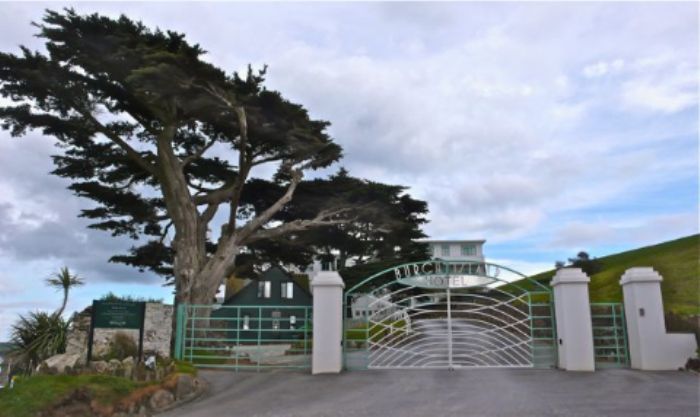
Entrance to Burgh Island hotel – guests only!

Arriving by helicopter – Burgh Island hotel
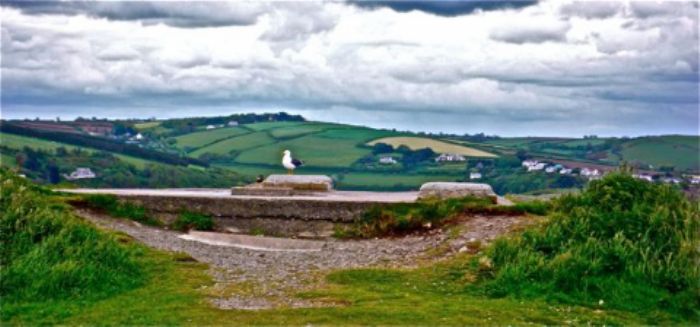
King of the castle – Burgh Island
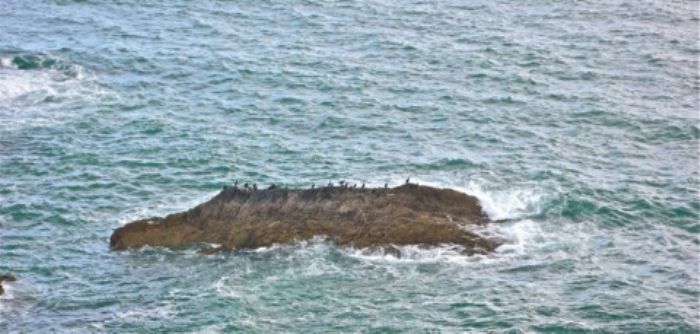
A sea monster shaped rock beloved by cormorants – Burgh Island
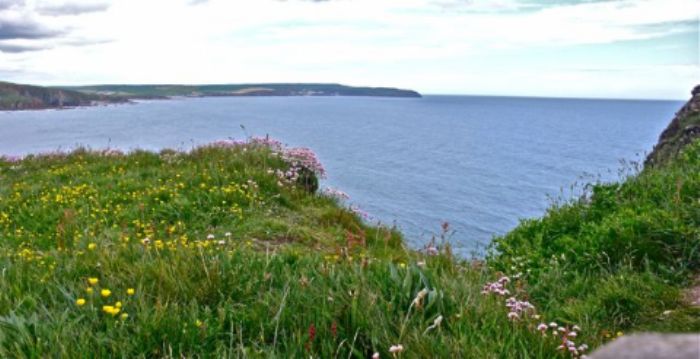
Sea thrift at the top of Burgh Island …
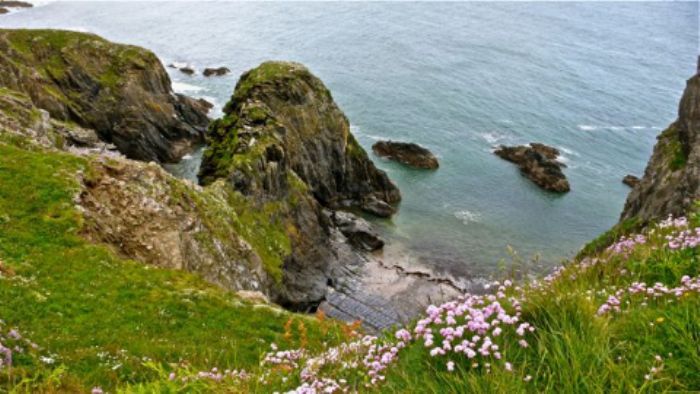
Secret unreachable coves – Burgh Island
As we walked over the cliff tops on the sea side of the island we were rewarded with more and more blue sky as a warm wind dissolved the heavy rolls of grey. And no bodies lying in secret coves.
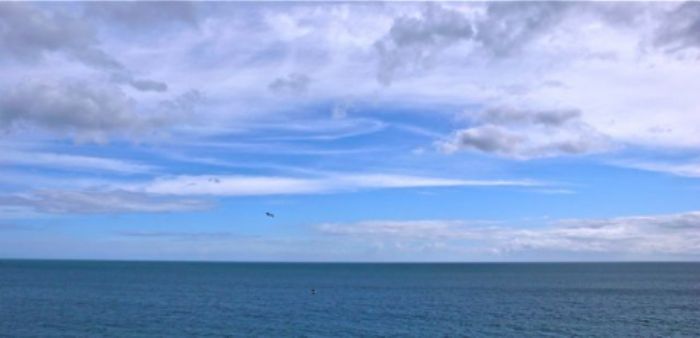
Blue sky over Burgh Island …
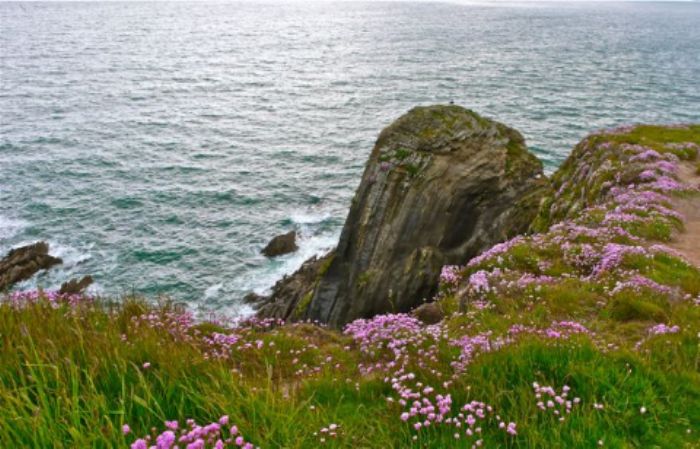
Pinks and greens – summer by the sea …
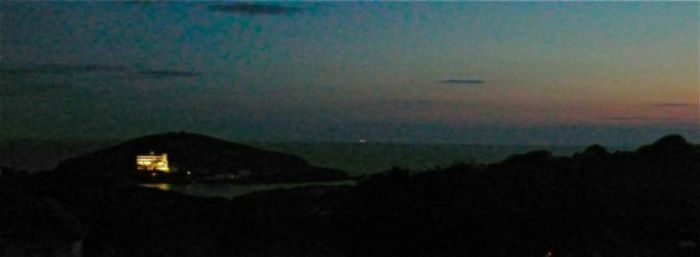
Our ‘room with a view’ at bedtime …
Note the light on the far horizon … through the binoculars, this seemed to be a brightly illuminated enormous ship. A ‘Marie Celeste’ mystery …
The hotel had only half a dozen rooms. There were three couples having breakfast the next morning. I identified them by the newspapers laid out at each table. FT/Times, The Daily Telegraph and The Daily Mail. The DTs were from London (I eavesdropped!) and kept to themselves as if they were rather special compared to everyone else. They talked ‘importantly’ in low voices and didn’t make eye contact. On the table next to us was a stocky man in his sixties with a big smile, sparkly blue eyes and a bluff manner. His partner was quite a lot younger and they obviously delighted in one another’s company. It didn’t take him long to lean over for a chat.
Roger and Gemma had been ballroom dancing in Torquay. He told me he had lost his wife a couple of years ago and met Gemma at dancing class. They did a lot of coast walking and told us how to climb down the steep cliff at the back of the hotel. Roger obviously still had a great zest for life – he and Gemma drove off with a flourish to Dawlish in his sparkly blue Porsche for another ballroom dancing soirée. He kindly left me his cliff walks map.
We could have stayed put and clambered up and down the rickety steps on the cliff face but we decided to explore further afield and drove to Overbeck’s garden, which is on another cliff top near Salcombe. Twisty, tiny roads, big drops to the shoreline and cars trundling large boats, trying to push us into oblivion. The road up to the garden was steep and zig zagged. And we actually had to park on the edge of the drop. This garden had to be good – and it was.
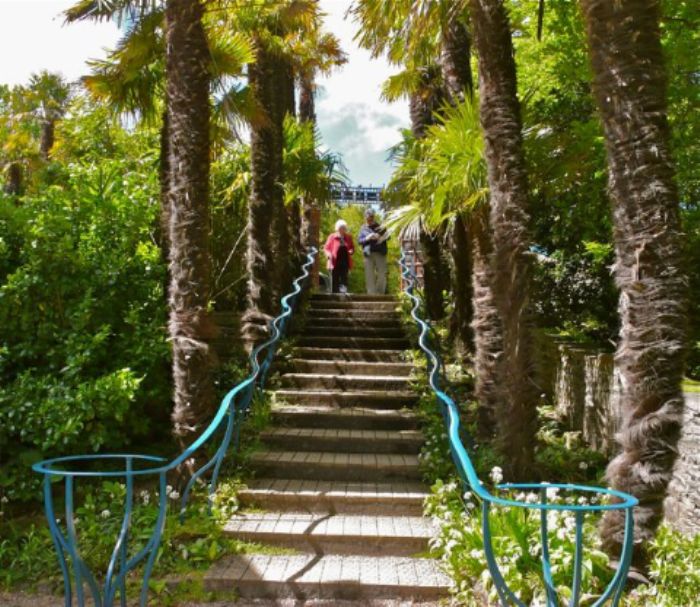
Entrance to Overbeck’s- Devon
Overbeck’s garden was bequeathed to The National Trust by the last private owner – Otto Overbeck (1860 – 1937). He was a scientist and inventor and a great collector. See John’s blog to find a photo of the Polyphon – an enormous musical box which uses giant metal disks with coded punched holes to make music of the time.
Like the Victorians, Overbeck had a fascination with the natural world and collected lots of insects and butterflies. Apparently, ‘beetling’ was a very popular pastime in the Victorian era.
A. A. Milne (1882 – 1956) wrote a poem about a beetle, which I used to know off by heart. It encouraged me to do the same thing as a child but with a ladybird – which also – happily – escaped.
‘I found a little beetle; so that Beetle was its name,
And I called him Alexander and he answered just the same,
I put him in a match-box and I kept him all the day …
And Nanny let my beetle out,
Yes, Nanny let my beetle out,
She went and let my beetle out,
And Beetle ran away.
She said she didn’t mean it and I never said she did,
She said she wanted matches and she just took off the lid,
She said that she was sorry, but it’s difficult to catch
An excited sort of beetle you’ve mistaken for a match.
If you want to hear more, look up ‘alexander beetle poem’ …
There is also an ‘electrical rejuvenator’ machine in the house – invented by Overbeck, which he claimed would help stave off the ageing process. It helped to make his fortune. He died aged 77.
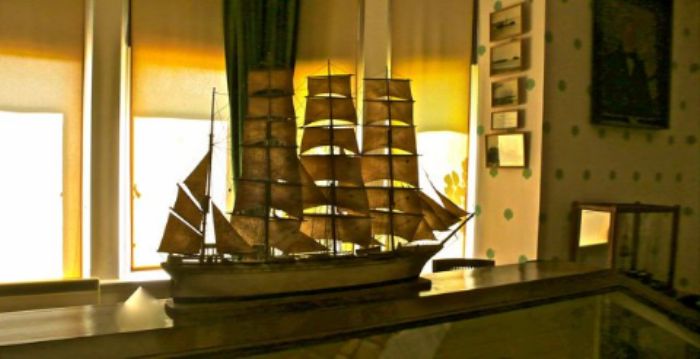
Overbeck’s house and garden – The Maritime Room
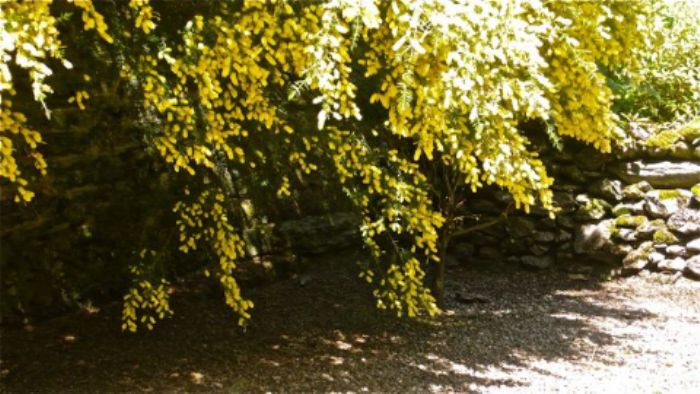
Snoozing in the sun …
During WW1, the Red Cross were able to use the house as a convalescent home for wounded soldiers. There are photos which show them sitting outside in the sun surrounded by kindly nurses. There was no record of any deaths. Fifteen of the soldiers ended up marrying Devon girls. Today the lawn is full of children, playing ball. The sun is still shining.
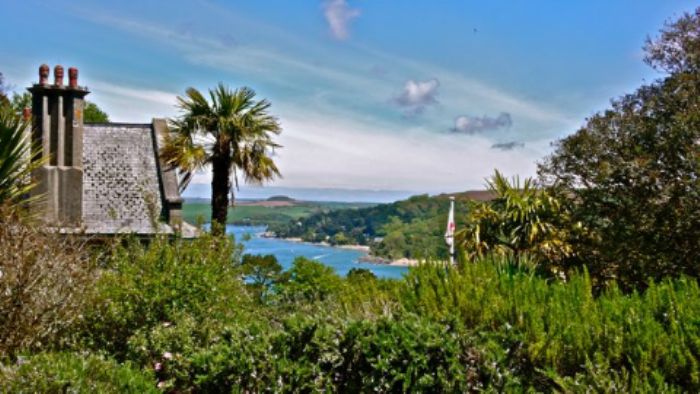
View of the bay from Overbeck’s garden
There is also a Tea Room, which proffered welcome refreshment. We sat by the large window, overlooking Salcombe and the estuary and watched the yachts, which looked like white feathers floating on the blue sea, reflecting the white puffs of cloud above. I had a ginger beer with my sandwich which perked me up. John bought a bottle of lemonade for an old man standing in the queue behind us. He perked up too.
Outside, we passed swathes of ransoms (wild garlic) under the trees. They have a pervasive smell which seems to get under your skin – not quite Chanel No. 5 – but very ‘natural’. Some older relative once commented on me when I first met John – ‘She’s very natural – is she foreign’?! Another great-aunt compared me to ‘The Birth of Venus’ painting by Botticelli … Oh dear, it’s often said that youth is wasted on the young but one can’t do much about it later …
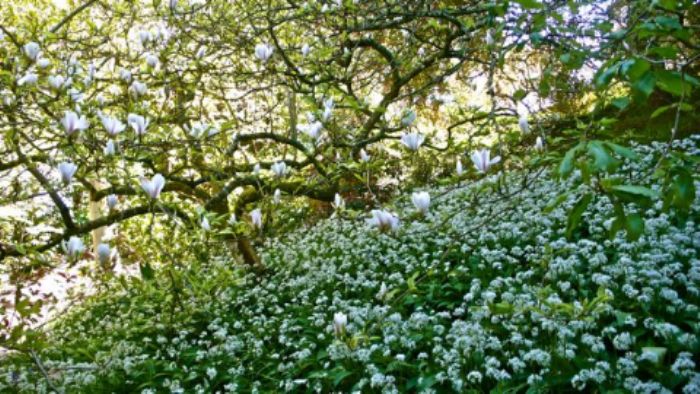
Magnolia and ransoms at Overbeck’s garden
‘Shall I compare thee to a summer’s day?
Thou art more lovely and more temperate:
Rough winds do shake the darling buds of May,
And summer’s lease hath all too short a date
from Sonnet 18, William Shakespeare.
The sonnet carries on though in optimistic mood and I felt the same as we explored the gardens, which are beautifully terraced with glorious views of the sea.
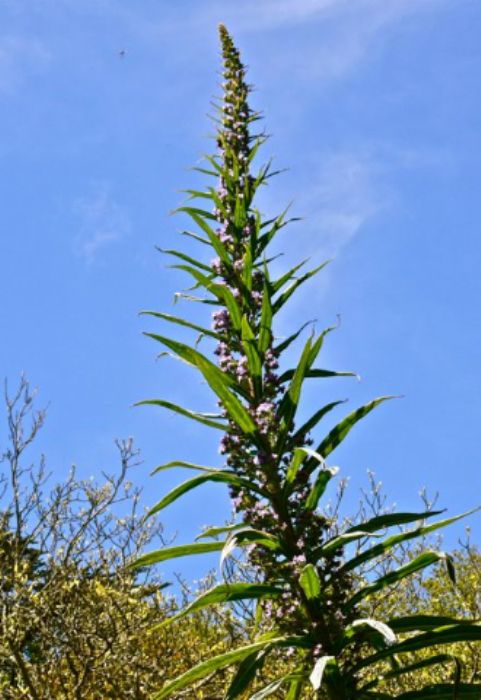
A ‘natural’ rocket …
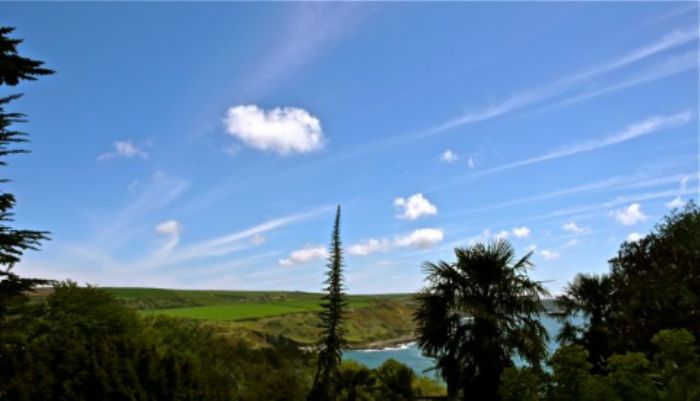
Summer sky at Overbeck’s garden
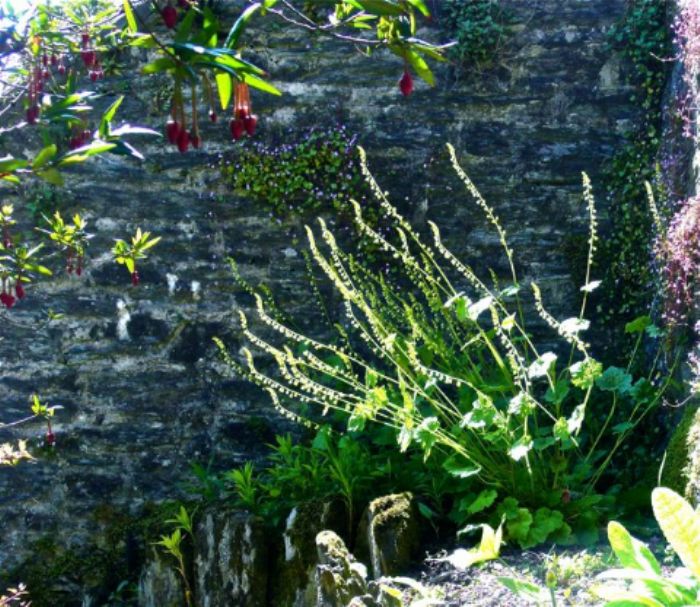
A sunlit corner …
We walked along terraces up high and down low and then through the trees until we came to the edge of the property. It was mid-afternoon, hot, still and silent. That time between 2pm and 4pm in the afternoon has always felt magical for me. Things have been achieved in the morning and there’s still plenty of time before evening sets in. Even if I’m in the middle of doing something, those two hours are when I feel most relaxed and at one with the world.
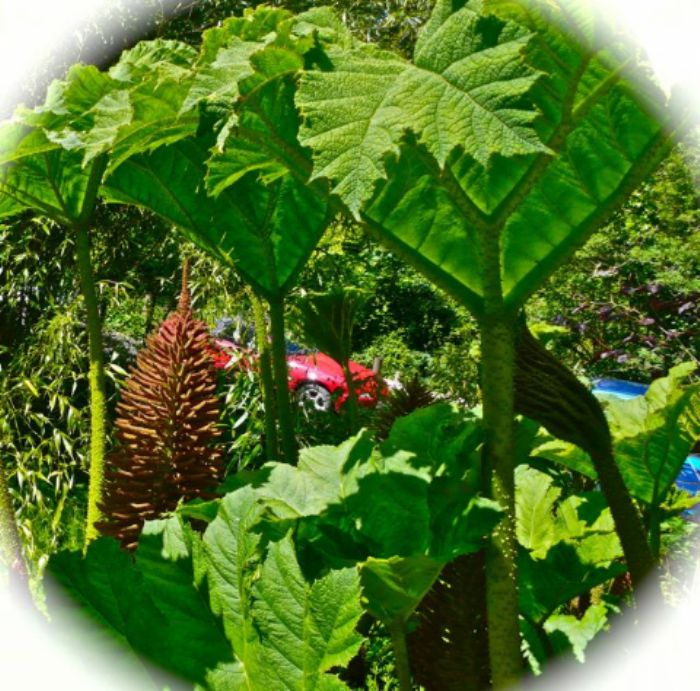
Red car in danger of being swallowed by giant gunnera …
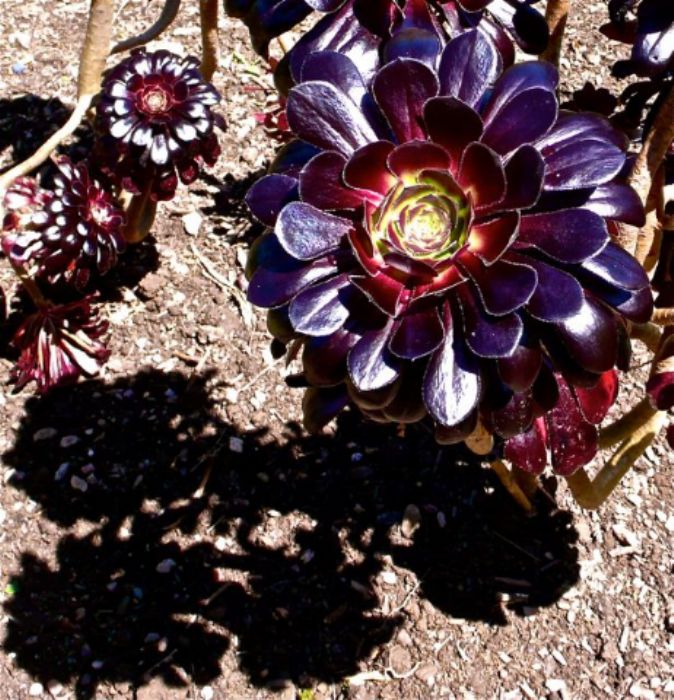
Darkly exotic …
Despite cold winters, exotic types of palms and plants seem to be able to survive here and it’s quite special to have such a mix. We were lucky that as the spring flowers were late we got the best of both worlds.
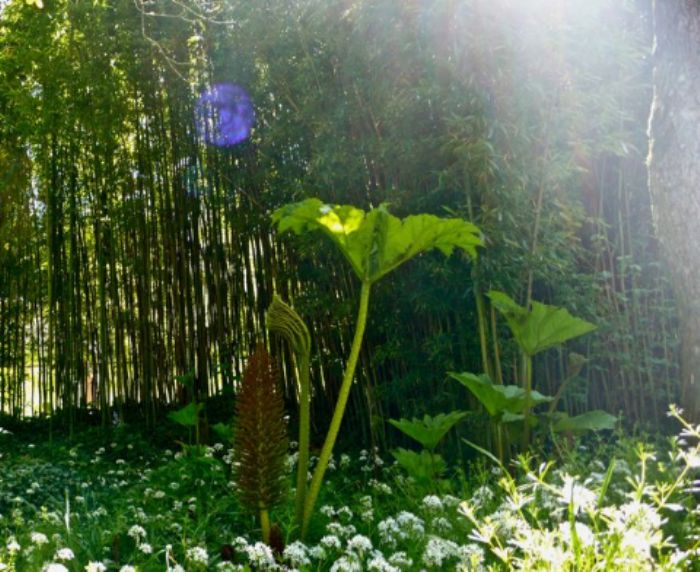
Farewell through the bamboo …
Then it was time to make a heart stopping three point turn in the narrows and it was a relief to finally get down the winding track to South Sands – a small beach full of children, boats and dogs. There is a large car park behind the trees. I would leave the car here on another occasion and walk up the hill – what is called a ‘Devon’ mile!
Back at the hotel there was tea and cake in the garden, followed by wine and a delicious dinner. If you stay here don’t miss it! Martyn is a ‘chef’ extraordinaire. And Petra a hugely welcoming hostess. John did some writing on the book while I immersed myself in ‘The Humans’, sitting in a comfortable armchair in the window nook, looking out over the bay.
There are a lot of good writers but although I know they are good, many don’t appeal personally. I feel I would get on with Matt Haig. He sees the world in a similar way to me and I can’t put down the book! Yet I don’t want to finish it … and I sort of wish I could have written it myself. I think it will make a good film.
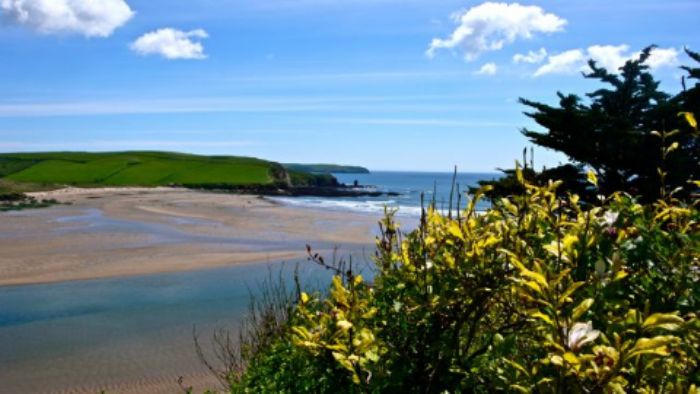
Sitting in the garden, reading ‘The Humans’ by Matt Haig …
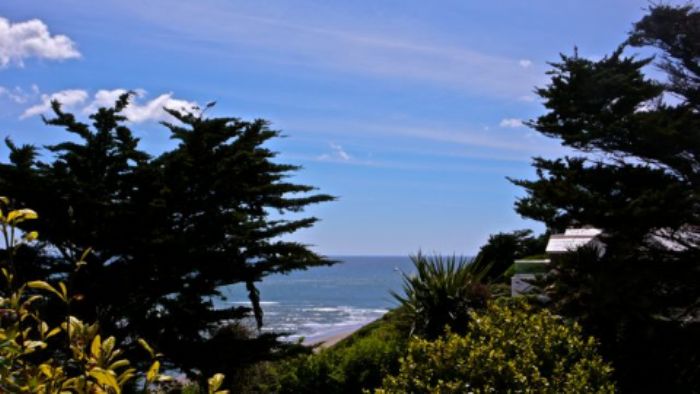
Henley Happy Hour – dinner on the horizon …
On our way back yesterday I saw a signpost to Loddiswell – nearby is an Iron Age hill fort called Blackdown Rings. The new day was sunny and breezy and after almost bulldozing our way through high banks of nettles and overgrown pathways, we finally emerged at Blackdown Rings. Iron Age hill forts needed panoramic views all around and this was how John identified its location.
There was a small, empty car park – no charges – but we put some money in a donation box by the stile. Ahead of us were a flock of sheep. I’m quite nervous of big animals ever since we were chased by a herd of bullocks in my childhood. It was because they spotted the dog. We had to race across the field and throw ourselves over a 5-bar gate. They had jostled us, lowing like drunkards and now, with lolling tongues, they peered at us sullenly, disappointed that we were just out of reach.
It reminded me of reading a book called ‘Crowds and Power’ by Elias Canetti. It was considered a classic. I find crowd behaviour terrifying, even when peaceable.
Luckily, the sun was hot and the sheep, crowded together under a tree for shelter, ignored our approach.

Flock of sheep – Blackdown Rings
There were still bluebells everywhere and I wondered if that was the same when the Iron Age people were padding around, surveying the panoramic 360 degree landscape. There are also the remains of a Norman Motte-and-Bailey in one corner and I knew John would be up there in a trice. He always aims for the highest spot. The silence was profound – adding to the beauty of the surrounding countryside.
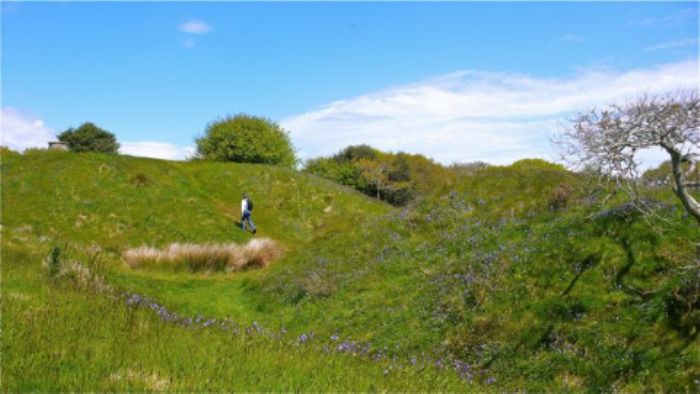
John climbs up the remains of the Motte-and-Bailey – Blackdown Rings …
We move on to Dorset tomorrow and wanted to walk along the sands, so it was back to the hotel and the rickety cliff staircase.
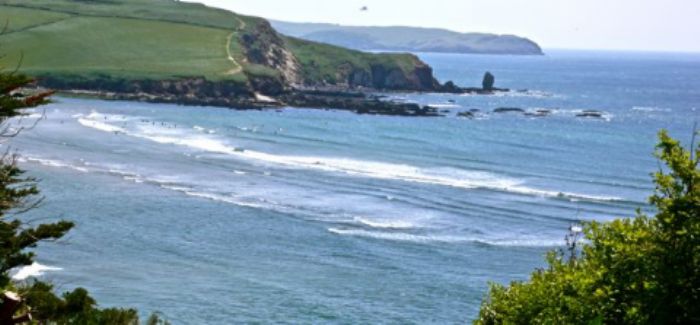
Surfers
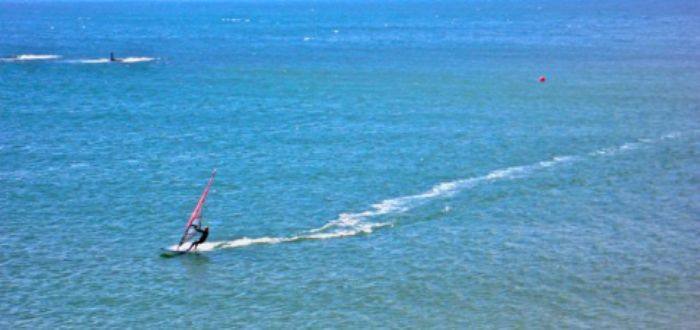
Tide coming in – windsurfer
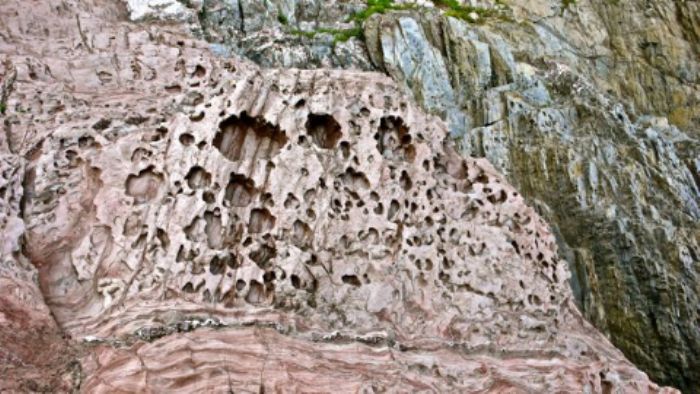
Cliff face full of holes …
Down on the beach with the tide going out – soon we will be able to walk around the headland to the island. Meanwhile, right by the water’s edge, we came upon a shoal of fish, some of them twelve inches long, their fins breaking the surface of the water as they swam around in a leisurely fashion, enjoying the warmth of the shallows, the sun on their backs. Grey mullet, we thought.
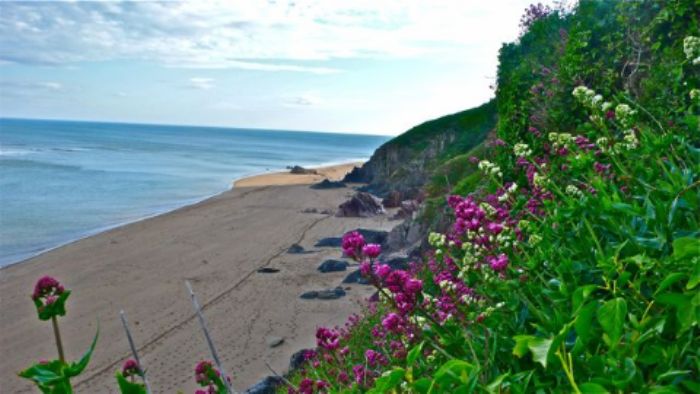
Half way up the cliff, looking down at footprints in the sand …
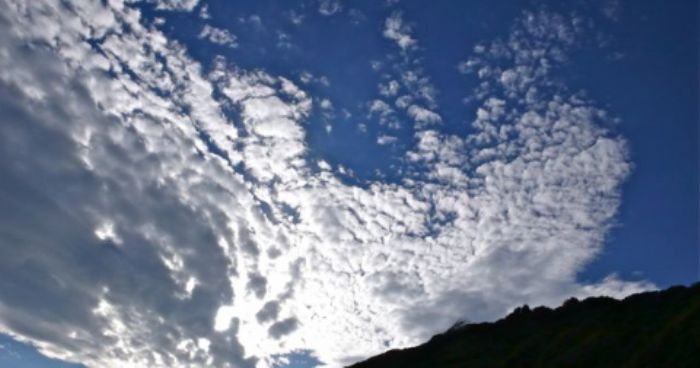
Looking up and feeling dizzy – hold on!
We clambered up into the garden at the back of the hotel and watched a small boat going out fishing before making our way to the dining room. I never like saying goodbye but this has been a great start to the week.
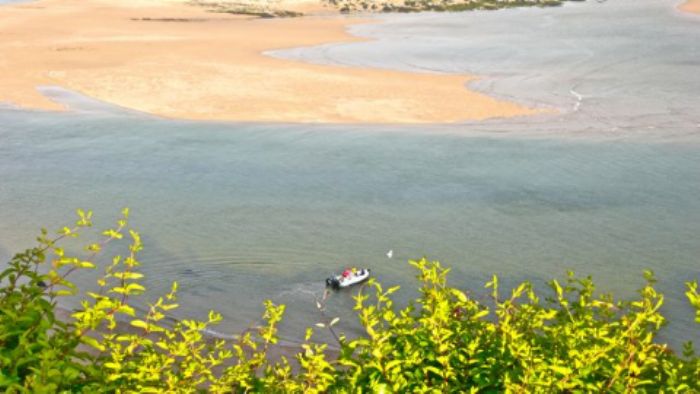
Small boat going fishing in the golden evening sun …
DORSET
We set off early as we wanted to see some friends on the way. They live on the banks of the river Dart on the edge of Dartmoor and have built a ‘Mies van der Rohe’ type house, which is spectacular. At the cutting edge of design, yet fitting in with and even miraculously enhancing the landscape.
However, the car was once more tested to its limits as we took a turn down to the river. The unmade track was made up of ancient, deep potholes, grass two feet high in the middle. Wrong direction – steam coming out of our ears. Urban car bewildered yet continuing stalwart. The right direction wasn’t much of an improvement but finally the arrival was worth the aggro! The river is clear, moving fast but with deep, limpid pools for swimming.
Next stop, Plumber Manor – near Sturminster Newton. This old house sits amongst a haven of green. We crossed the river by a small white fenced bridge and parked under an enormous tree. The family have owned this site since the time of William the Conqueror and the present generation of it made us very welcome. Our bedroom was at the top of the stairs, where a portrait of Charles II inspected us closely. John is related but on the wrong side of the blanket. Could hardly wait for dinner and bed – both delicious and comfortable … zzzzzz ….. sea and country air offer very sound sleep.
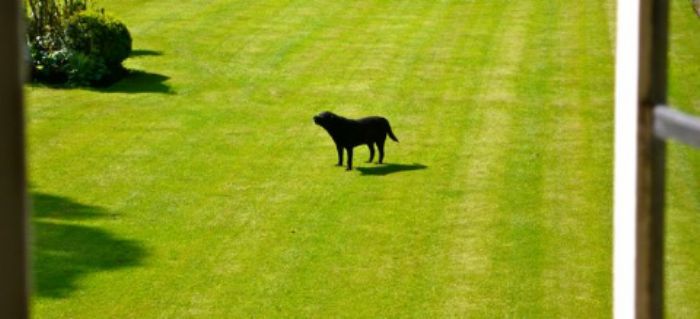
View from our bedroom, Plumber Manor
We were recommended to go to Milton Abbas where there’s an abbey, a school and a ‘model’ village. Up on the top we had a wonderful view of the surrounding countryside at Bulbarrow before swooping down into the valley – we are getting better at driving along narrow country lanes!
Devon is somehow the extrovert county, Dorset the introvert. Both are fabulous but today I was entranced by the magical quality of the rise and fall of the landscape, rolling us up in a green and yellow carpet, dappled in sunlight.
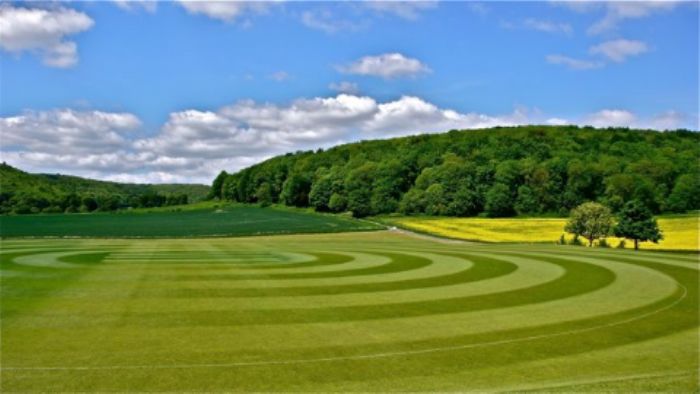
Down in the valley near Milton Abbas
After exploring the old abbey grounds, now part of the school, we drove round into the village. This was the first ‘planned’ village in England, it is said. Lord Milton, who was 1st Earl of Dorchester and owned Milton Abbey, decided to move the original village, as it spoiled his view. It was relocated at Luccombe Bottom with the help of an architect and the landscape gardener, Capability Brown. The original village was demolished. Just the buildings … town planning was in its infancy but I think the villagers survived …
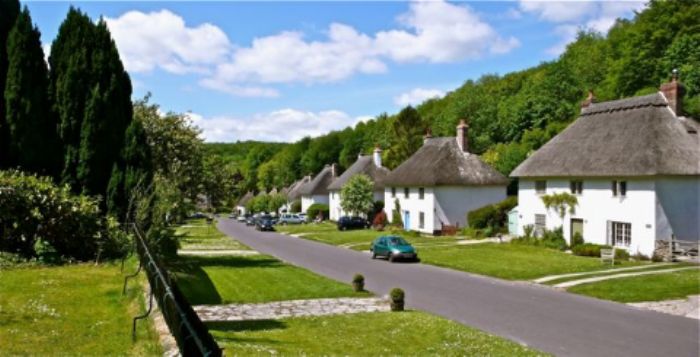
The ‘planned’ village of Milton Abbas …
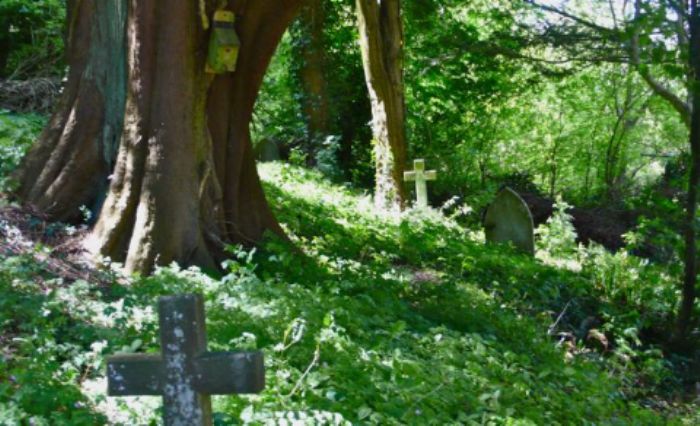
Milton Abbas churchyard
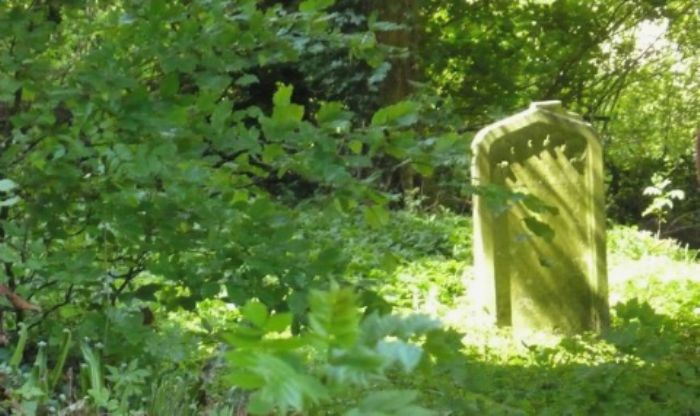
Gravestone bathed in the warmth of the sun …
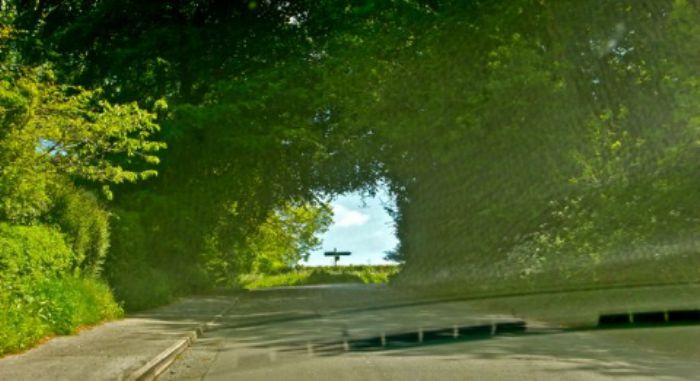
Pointing the way ahead …
Next stop Blandford Forum, where we parked by the river and walked up to the High Street. I noticed a bookshop and found Agatha Christie’s ‘Evil Under the Sun’ for 2.50. A ‘must’ after visiting Burgh Island! The last time I read Agatha Christie was in the sanatorium at school when I had bad ‘flu. The ‘san’ was set on the edge of the playing fields, surrounded by trees. I could hear the ‘pop’ of tennis balls near at hand but I wasn’t allowed visitors. Meanwhile, I devoured a whole shelf of Agatha Christies and I’m sure it aided my recovery … and she still seems to be the world’s best selling author … after all these years!
Bryanston school is nearby. We bought some cider and sandwiches and sat by the river, watching the boys rowing.
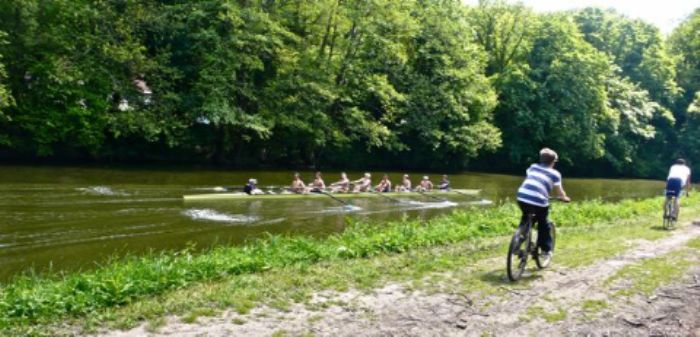
Rowing at Bryanston
On the way back to Plumber – and dinner – we stopped off at Sturminster Newton water mill. There used to be mills like this a mile apart all along the river – but no more. This one is the best preserved.
The water mill started me thinking of Constable’s style of painting. He was brought up in Suffolk with a wealth of water mills all around, which he loved. Constable said he was trying to establish on canvas ‘English sunlight running through moist air, the wind rustling foliage and wimpling the water’. He also said ‘the sound of water escaping from milldams, willows, old rotten planks, slimy posts and brickwork … I love such things …Painting with me is but another word for ‘feeling’. Constable’s brushwork is swift, free and open – just like rushing water ….. he also used a method of painting called ‘scumbling’ to try and catch ‘one brief moment caught from fleeting time’.
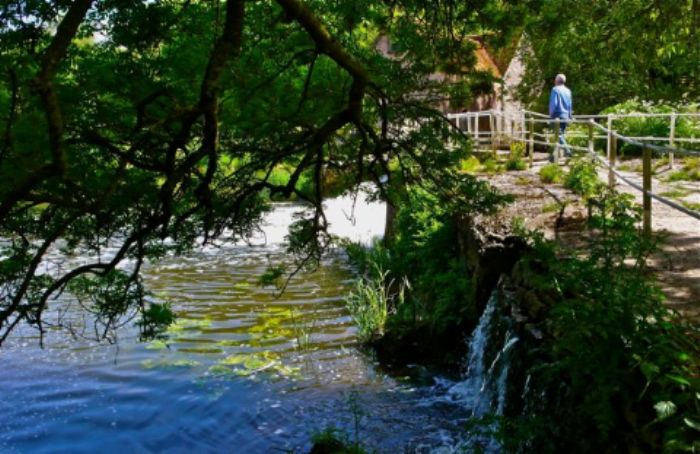
The mill race at Sturminster Newton
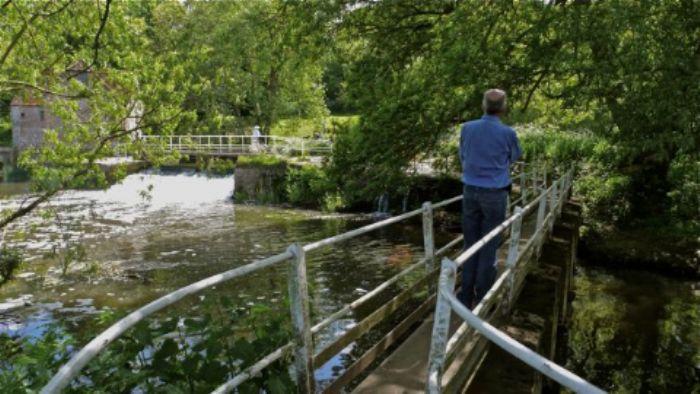
Sturminster Newton – crossing the bridge …
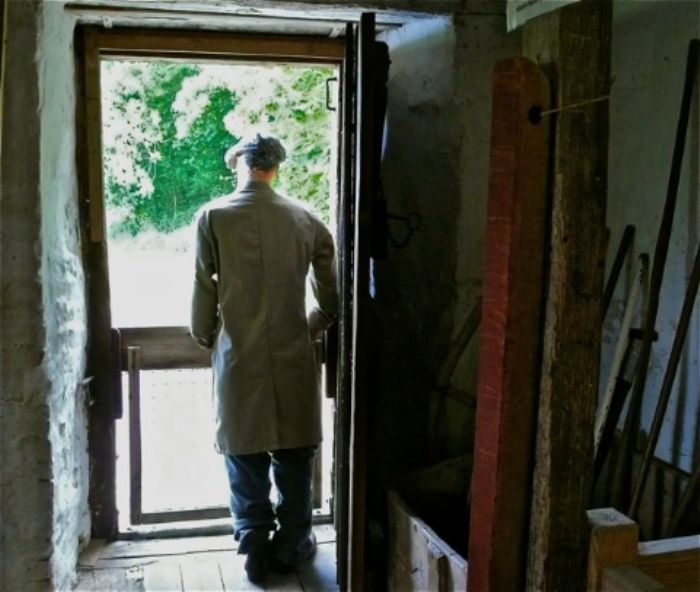
Sturminster Newton – The Miller’s Tale
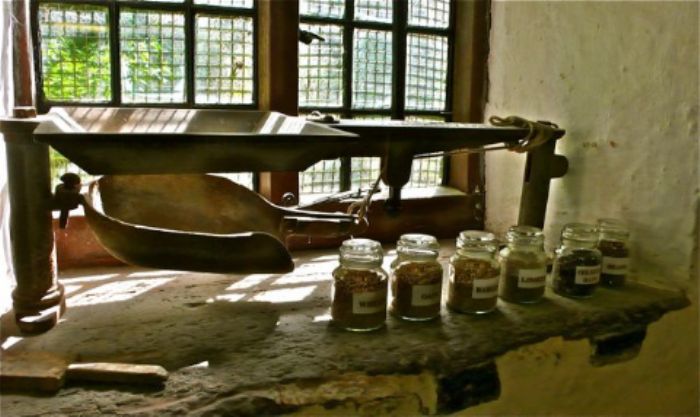
Sturminster Newton – inside the mill
Thomas Hardy lived in a house by the river here when he was writing ‘Return of the Native’.
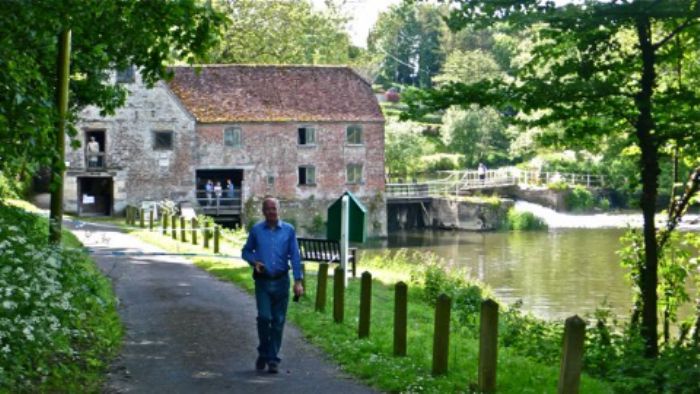
Evening sunshine at Sturminster Newton water mill …
Finally, the short distance back to Plumber. On the road we kept passing a sign which said ‘Cats’ eyes removed’. I thought this might shock foreigners who weren’t aware of what it was referring to. The savage customs of the English … leave kitty at home! However, the man from the North, Percy Shaw, who invented cats’ eyes for the road probably saved the lives of many motorists.
Hod and Hambledon hills near here were both Iron Age hill forts. The next day – Sunday – we drove to Child Okeford from where you can climb up Hod. Last time we did this – about four years ago – I remember seeing the most beautiful butterfly as I jumped over the stile. It was delicately patterned in shades of brown like filigree and spotted with small gold dots that shone like jewels. Today the whole hill was peppered with buttercups and daisies, speedwell, cowslips, dandelions. plantains (we used to call them soldiers) and rock rose.
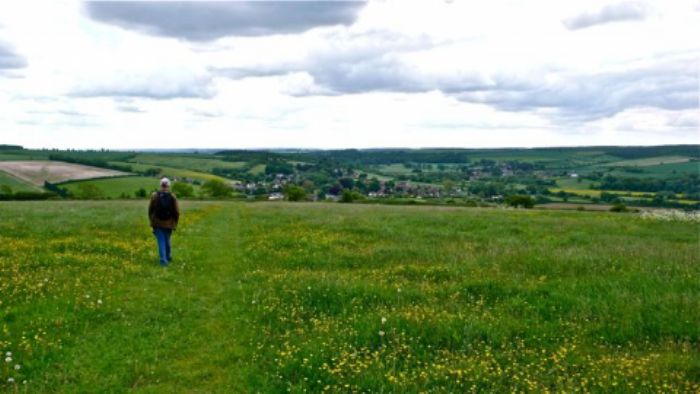
John on top of Hod Hill
We met a woman, who looked as though she was from the Iron Age. She was big boned with an old fashioned face. If I say she resembled a mare, it was an attractive mare. We sat and talked for a while and then I followed John around the ramparts. We could see lots of regular hollows – maybe former dwellings, grazings or just shelters for animals. Two yellow brimstone butterflies fluttered by. Next time we must do Hambledon. We had to be back at Plumber as a friend from long ago who worked at ‘The Ecologist’ with Teddy Goldsmith was coming over to see us.
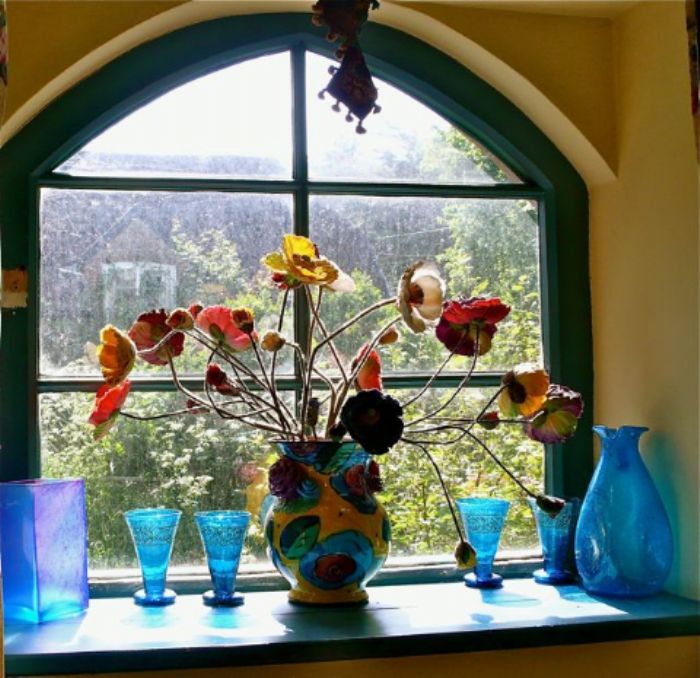
Window box
I had suggested to John he look up Nicholas because I thought he lived in Dorset and it turned out he was a ten minute walk over the fields from Plumber. So he came over and we made our way back to his house – more sheep to contend with – these ones were quite frisky with very dirty bottoms. We managed to find the way back later, only to have another drama.
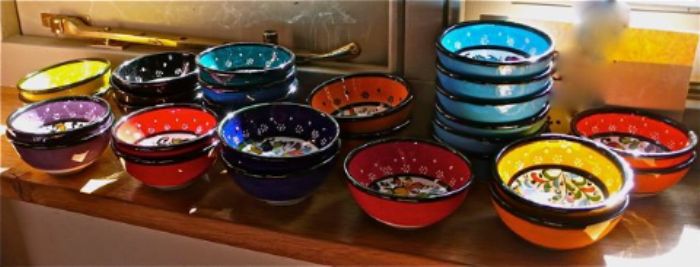
A Turkish window box
John suddenly realised he had left his bag with camera and car keys at the house. Nick was leaving for Prague not long after we left, so it was touch and go. Mobile phones not reliable in this neck of the woods! While John thrashed his way through the undergrowth terrorising the sheep, I lay on the bed and read Agatha Christie. John was (just) successful and returned in time for dinner and to be seduced by the ‘sweet trolley’!
The sun is again high in the sky. We got to the car, only to find it had been shat on in full force during the night by what must be enormous pterodactyls in the tree above. A bucket of water was needed and failing any cleaning fluid, I used my shampoo and found the frost scraper in the boot. Not such a good parking place after all.
Shaftesbury wasn’t far away so we thought we’d take a look. It’s the highest town in Dorset and there’s a great view from the garden of the now ruined abbey. Gold Hill is where the TV ad for Hovis was filmed. Steep, cobbled, old fashioned and much photographed.
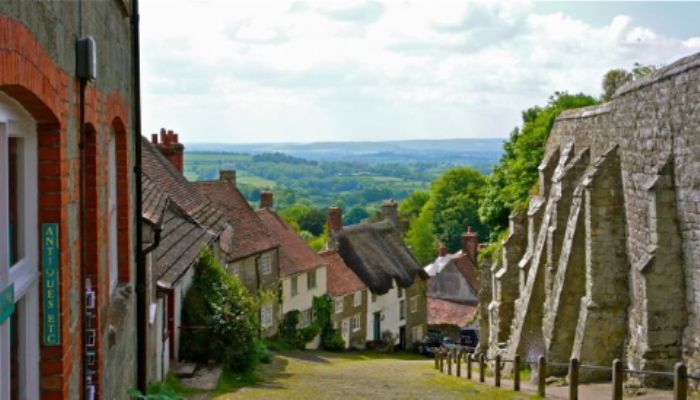
Shaftesbury – Gold Hill …
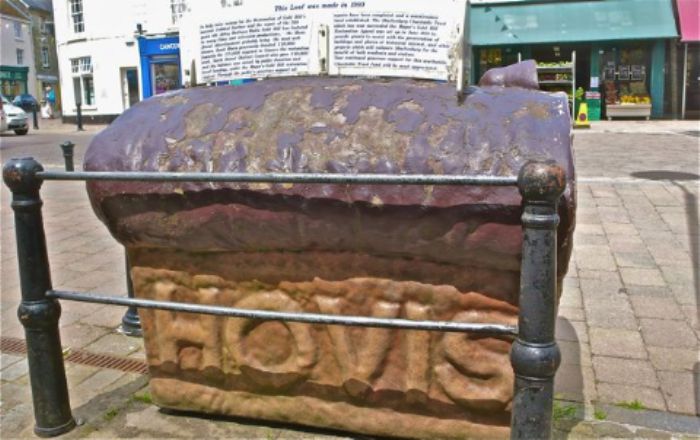
… of ‘Hovis’ fame!
John ended up buying a pair of pink trousers – in appreciation of the summer weather. Caroline, his sister, seemed to think they were only worn by certain ‘types’ – one being antique dealers. Maybe he could take that up as a second string to his bow. The colour quite suits him and it’s a change from jeans that everyone wears now. He is looking relaxed and optimistic. Dorset invites a slower pace of life and we seem to be taking to it – although evenings are reserved for book writing.
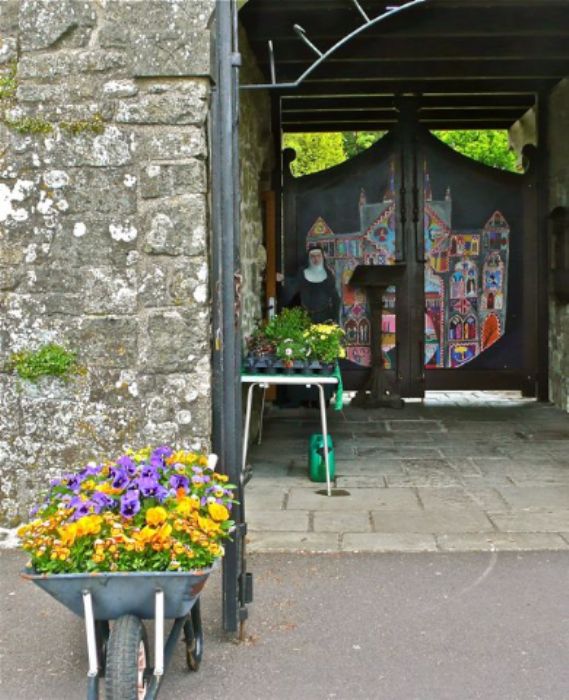
Shaftesbury – entry to the abbey gardens …
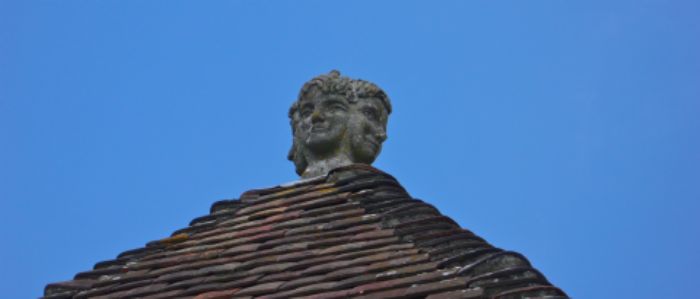
On watch at the abbey …
We explored the abbey grounds and I bought some giant marbles in the shop. I don’t know why. It just felt satisfying to hold one in my hand. They are clear with yellow and green swirls – a bit like the Dorset landscape. I’ve also just finished a Simenon/Maigret book called ‘Maigret et le clochard’. I was very touched by what Maigret did with Toubib’s marbles. Simenon is definitely not just a crime writer. His understanding and relaying of the human condition to his readers is for me second to none and, being understated, makes much more of an impression. Maigret is special. I have a fantasy of being Mme. Maigret at times.
My mind was wandering towards my stomach and found itself strongly drawn to a slice of Dorset apple cake… ‘The Salt Cellar’ is a popular restaurant at the top of Gold Hill but it was busy and King Alfred’s Kitchen on the High Street was the place we chose to sit down. It’s run by a French woman and her husband and I would go back to Shaftesbury just to have another enormous slice of his apple cake – the best ever!
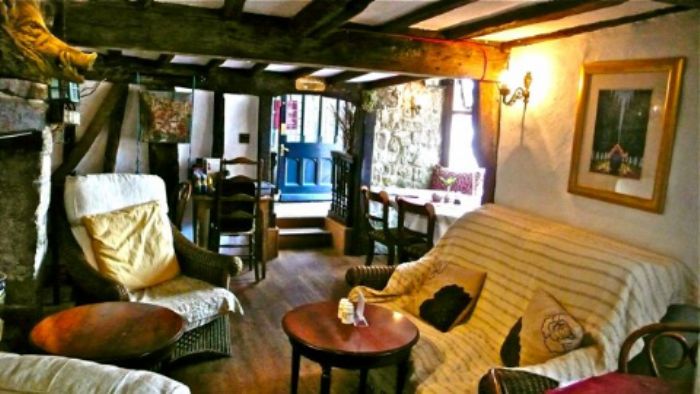
King Alfred’s Kitchen – much enjoyed …
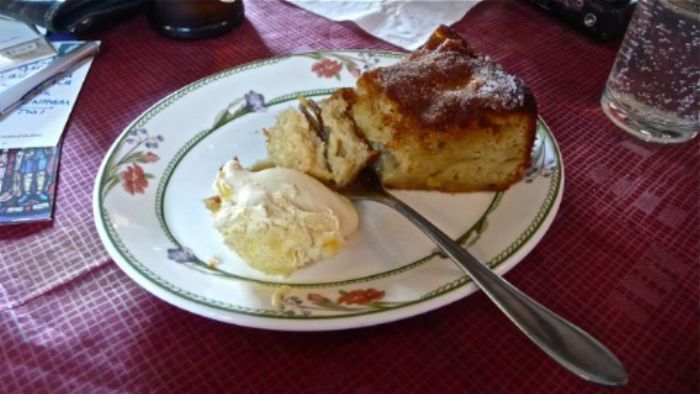
Dorset apple cake with clotted cream – I could eat it all over again!
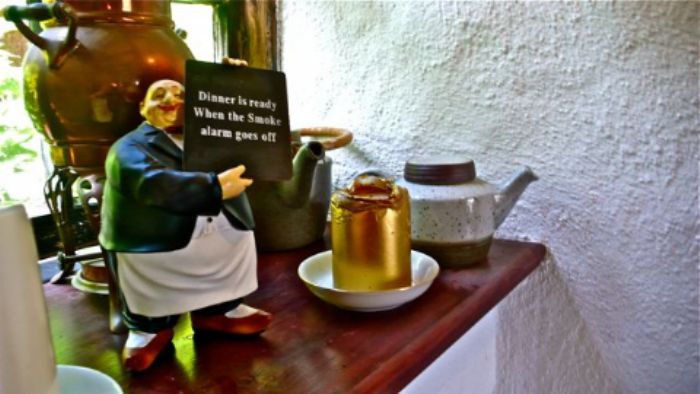
If the apple cake’s anything to go by, I’d happily stay for dinner …
I shall remember Shaftesbury for pink trousers, yellow and green marbles and oozy apple cake with clotted cream. This marble fetish is reflected by the bottle glass window – looking through a glass sphere at the local high street. Is that bus a mirage? Public transport is a bit of a problem in the countryside but it does seem to turn up from time to time.
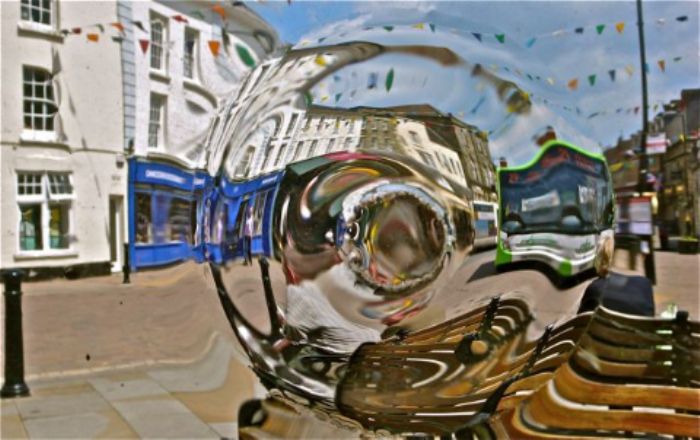
King Alfred’s Kitchen – view from restaurant via bottle glass window …
I’d noticed a small museum near ‘The Salt Cellar’ and persuaded John that it was worth a look. There are some wonderful Dorset ladies here who run the whole show.
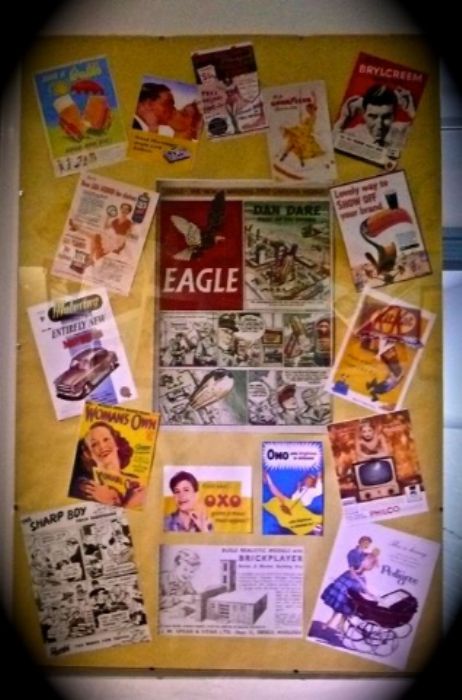
Shaftesbury Museum – a collection of 50s posters and magazines …
There was an old film running on an old TV, showing a ‘Miss Marple’ figure standing watching American tanks coming through Shaftesbury during WW2.
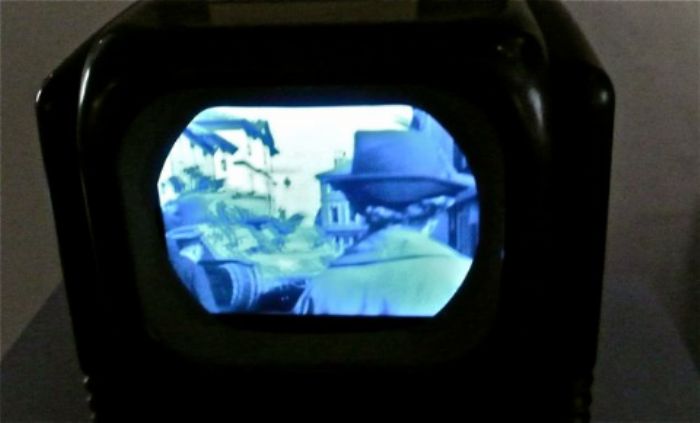
Miss Marple investigates
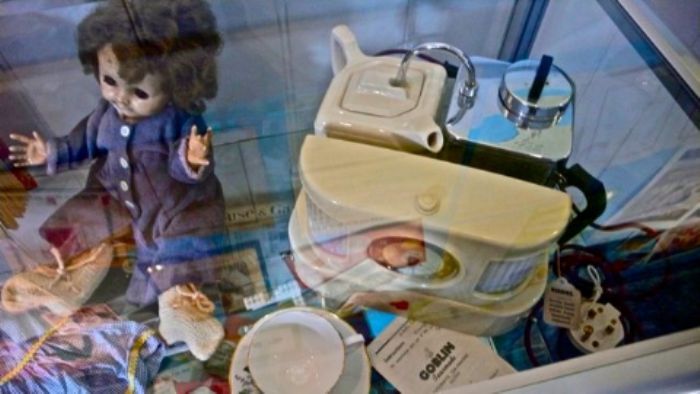
Relics from the 1950s!
This photo has special memories for me. It’s not the doll I used to have – but the boyfriend, whose parents gave him a Goblin Teasmade for his 21st birthday?! No etchings in sight here – only the unmissable cup of tea. I could do with a Goblin Teasmaid now, instead of being one …
And then it was time to walk back down the High Street, pick up the car (so easy to park here!) and make our way to Badbury Rings.
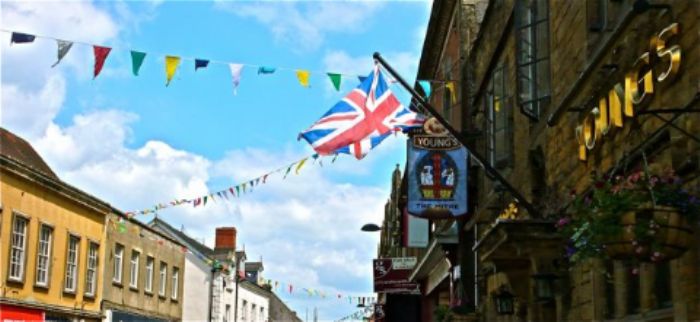
Au revoir Shaftesbury …
Badbury Rings is an Iron Age hill fort which is quite small but perfectly formed. We walked all round the ramparts in half an hour. I could have lain down amongst the buttercups and daisies but I did notice some marauding black bullocks in the distance. This would be a perfect place for a picnic. However, I do remember once taking out a sandwich while we were walking in Switzerland – a greedy cow came out of nowhere snatched both sandwich and paper bag and ate the lot.
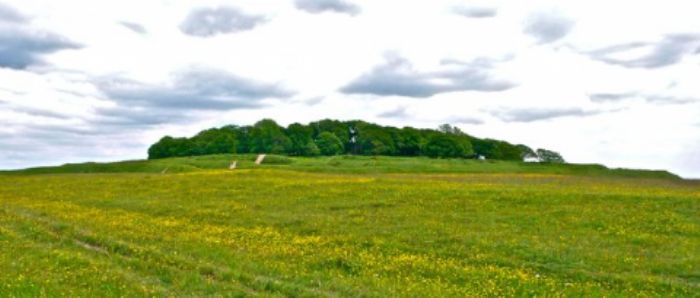
Badbury Rings – small but perfectly formed …

Not those pesky bullocks again?!
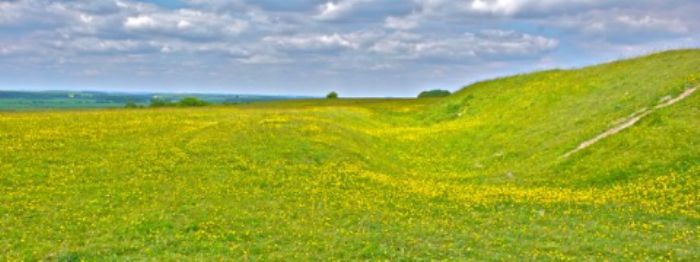
Where I wanted to lie down amongst the buttercups …
But rather than lounging among the buttercups, it was on the road again, bound for Kingston Lacy – ten minutes away. The house was closed for renovation but the gardens were open. We drove along a wonderful avenue of beech trees – apparently, these are being replaced by hornbeams when their life comes to an end. Hornbeams are more disease resistant. Glad to be in time to see these at their best.
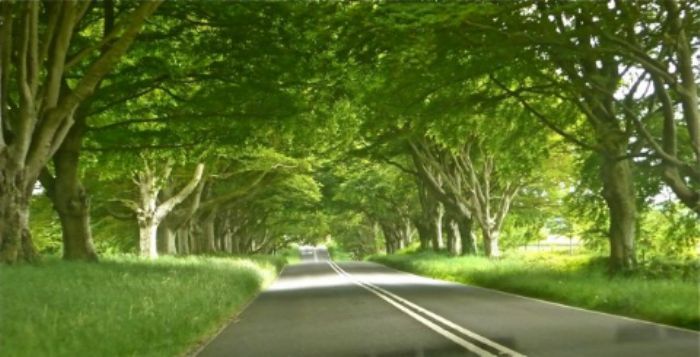
An avenue of beech trees lining the road to Kingston Lacy
The last owner, William Bankes, bequeathed Kingston Lacy to The National Trust. He travelled a lot in the Middle East and a large obelisk, resembling Cleopatra’s Needle, stands in the grounds.
There’s obviously a bit of wear and tear but I noticed something that resembled a crusader knight racing out of the stone on horseback straight towards me. I expect that’s rather fanciful but it’s not exactly like finding Jesus or Mary on a slice of toast…
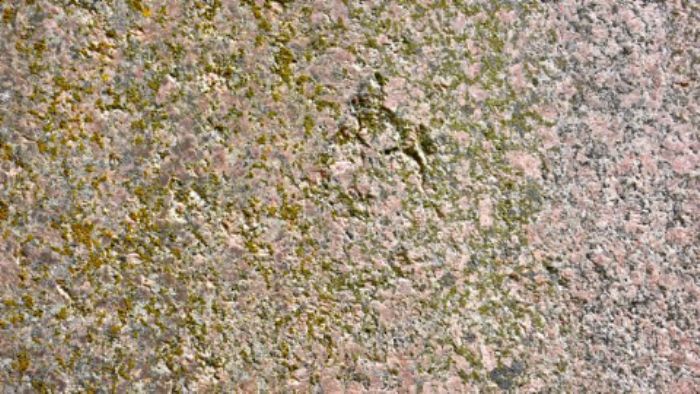
The Crusader and the Obelisk … ? Who has a good imagination?
John is very well read on this period of history. I think he was fired up by reading ‘Knight Crusader’ by Ronald Welch, as a boy. Over ten years ago we went to Syria and our walk around Krak des Chevaliers is still deeply imprinted on my brain.
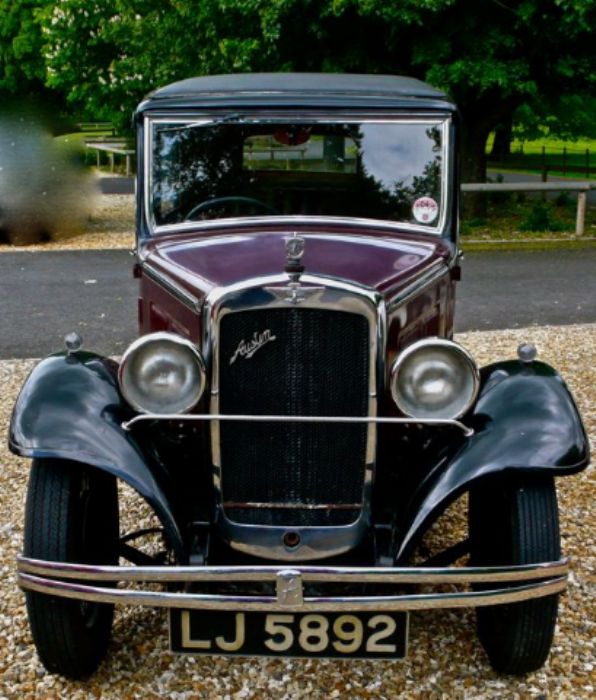
A beauty in the car park

Hedging at Kingston Lacy
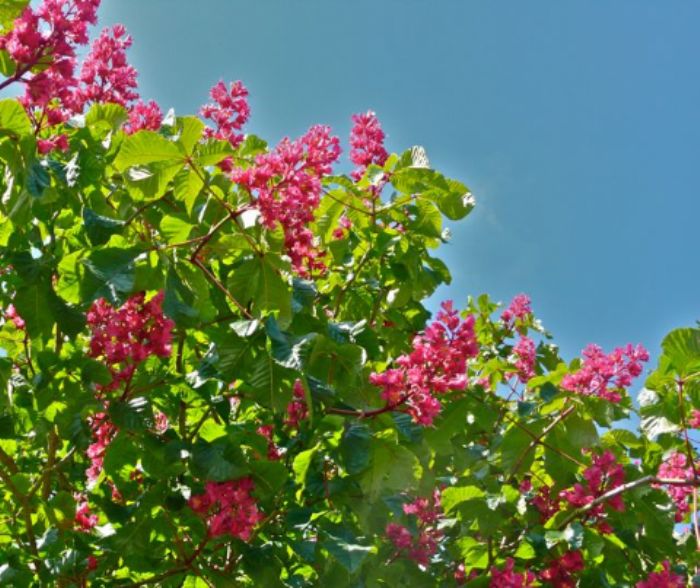
A pink horse chestnut tree
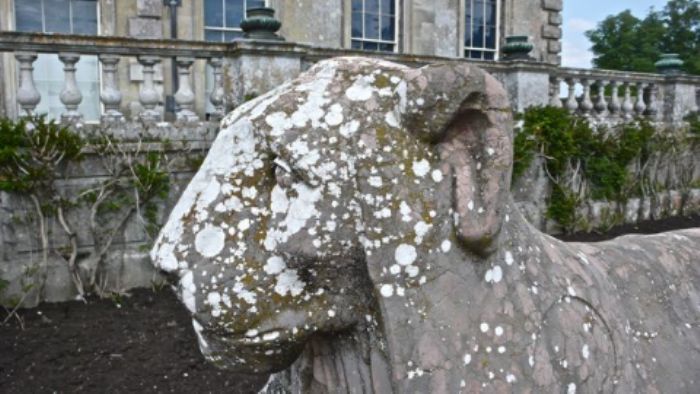
An ancient retainer – Kingston Lacy
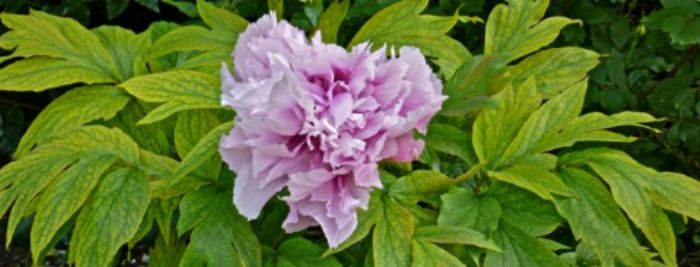
Kingston Lacy – paeony pink
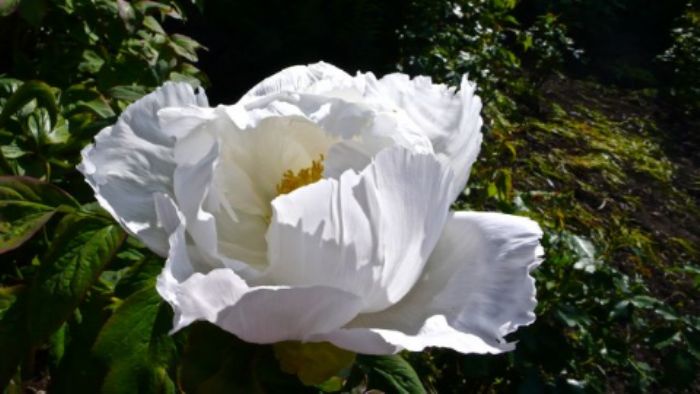
Kingston Lacy – and white …
Back to Plumber on a road as much unlike Hammersmith Broadway as you could hope to see! We are still on holiday!
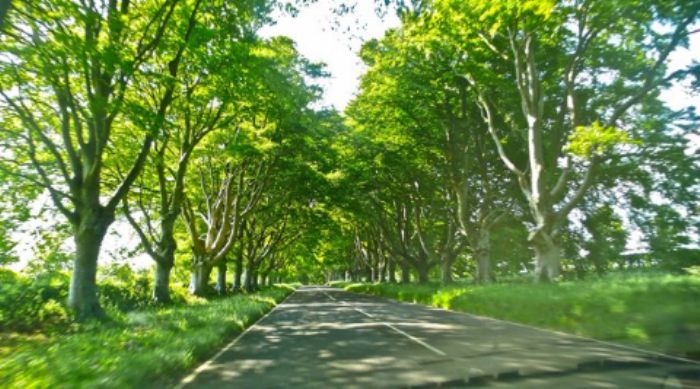
A sunlit evening on the way home …
I notice I say ‘home’ – Plumber gives me that feeling but we only have one more full day. This is to be spent with Julia and her new partner Jamie – a motorbike fiend but a very nice one!
On the way we are diverted by another huge piece of metal. Quite extraordinary!
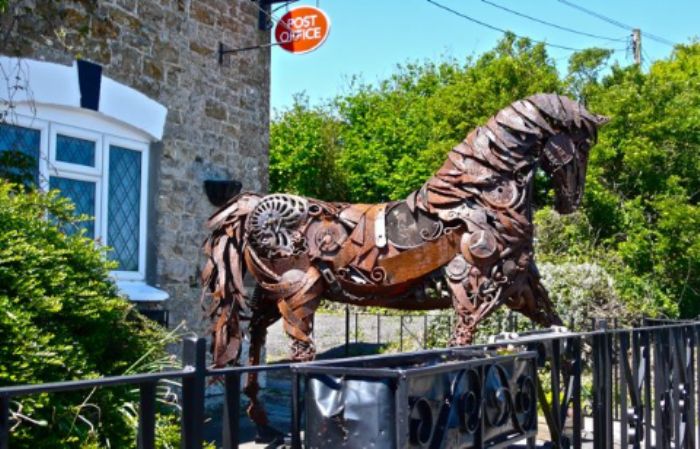
Waiting for a knight crusader …
Julia and Jamie live near Beaminster – and we attempted to travel cross country, where there seemed to be many dead ends. We passed by Bishop’s Caundle, Minterne Magna, Melbury Bubb (dead end!), Sydling St. Nicholas, Toller Porcorum, and we were only ten minutes late – tho’ slightly flustered!
It was great to see their new farmhouse – turn to John’s blog to see details of the afternoon adventure deep in the woods. My photos are not up to much, as it was enough for me to scramble through the undergrowth – but fascinating to see all this creative stuff going on in seemingly the middle of nowhere! John and Julia were greatly intrigued.
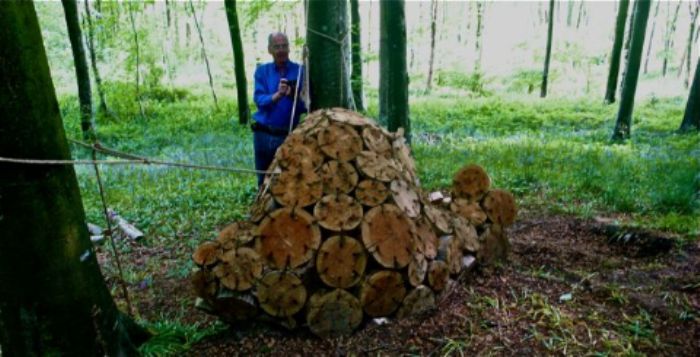
A genius seamstress at work in the forest …
The next morning we dropped by Bryanston school, where Julia’s son, Connor, took us on a tour and we got to see the Art Department, which is very impressive. This is also on John’s blog. On the way round, we met a maths teacher who was just about to retire. John remembered him as a boy at school! All I can say here is that whoever goes to Bryanston today is very lucky!
Sherborne was on our way back and we wanted to track down Tim Boon, who had a gallery in Barnes called ‘Amalgam’ for many years, before he moved here. It’s a very lovely, honey coloured town and seemingly well-to-do. We didn’t find Tim but John recognised a well known war photographer in the street. We walked by Sherborne school and then it was time to get on the road back to London.
Oddly, when we got home, there was a letter from Tim, inviting us to his last show in England. He was off to live in Australia.
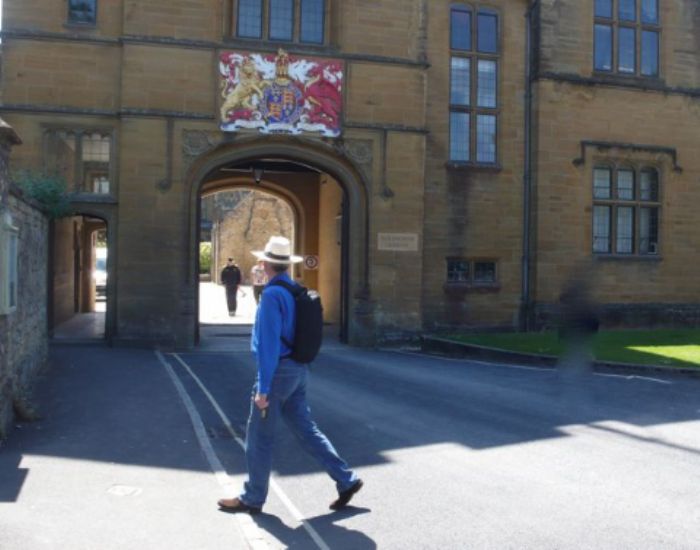
Passing the entrance to Sherborne school
I was rather dreading the drive home although it was shorter than coming. We made for Ringwood and the M3. But as we were leaving Dorset we were passed by a more ancient form of transport. A fitting end to the week. And we had cider in the boot of the car.
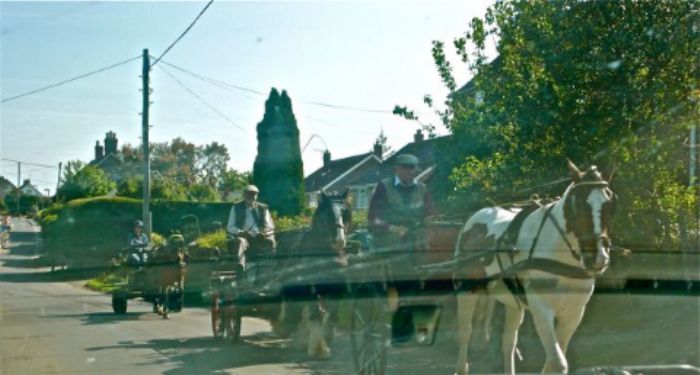
Leaving Dorset …
END

